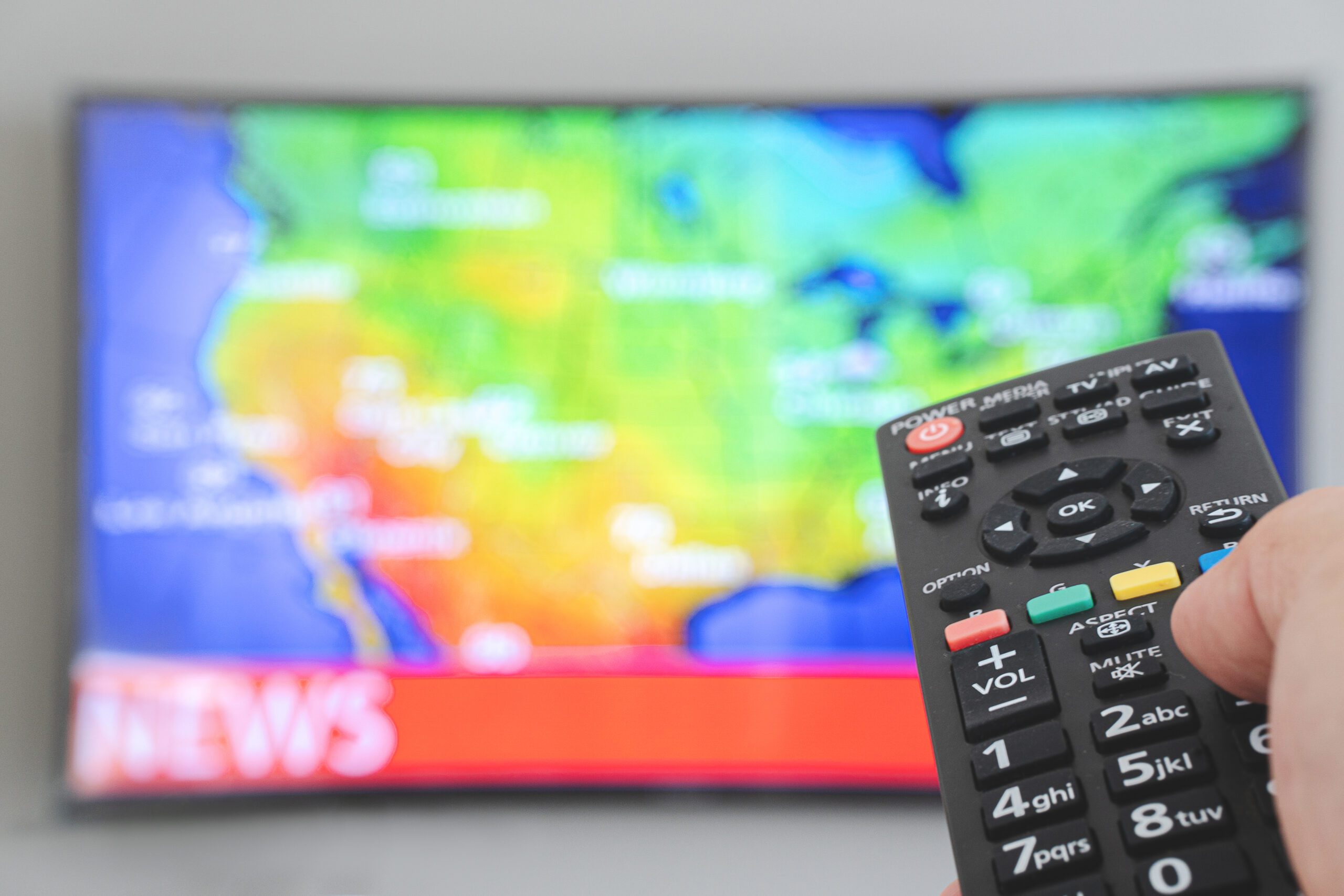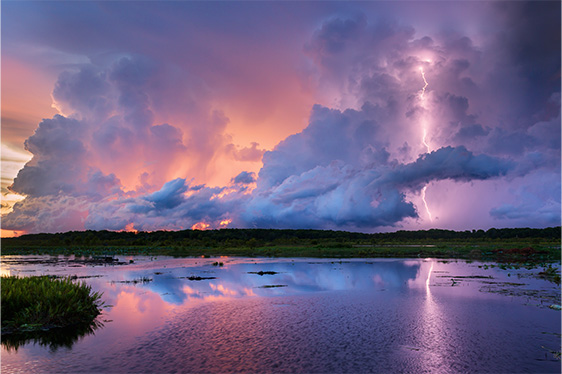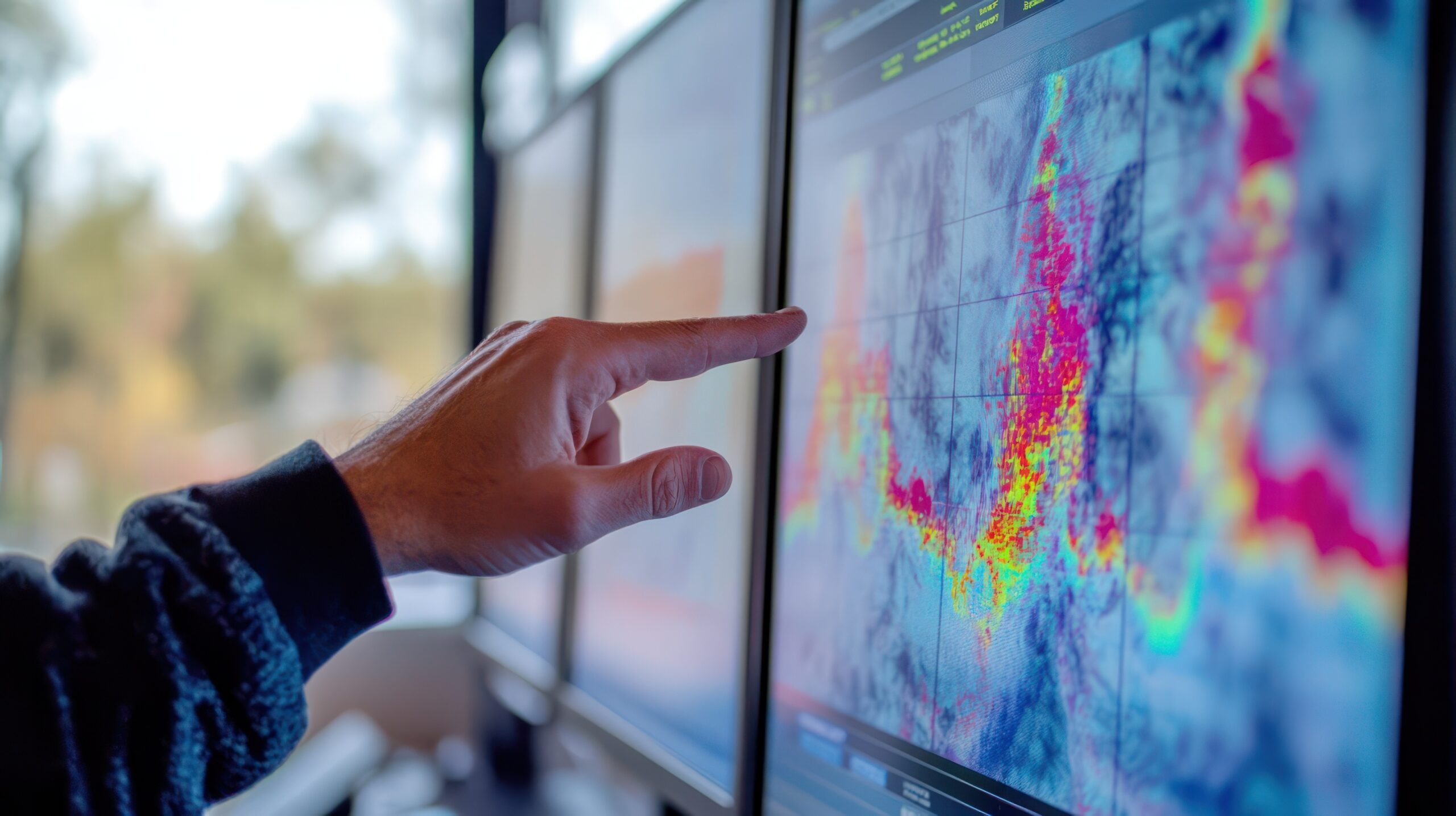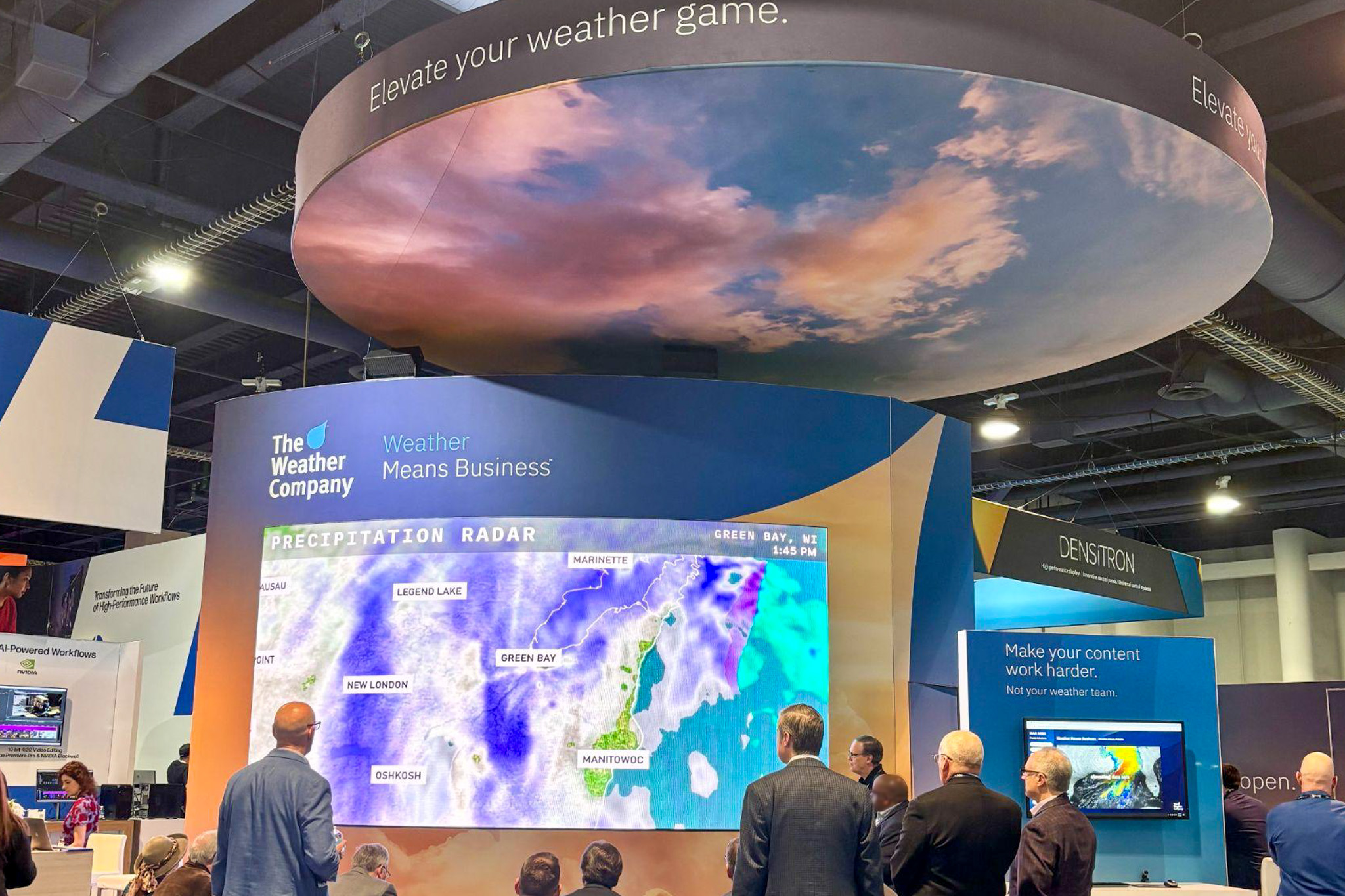Weather intelligence for the future: Crafting a strategic enterprise approach to changing environmental conditions
Continue readingKey takeaways
- At Boeing Field, The Weather Company’s embedded meteorologists (METs) identified a 50-mile cloud deck that would lift fog visibility, turning vague fog forecast probabilities into actionable timing windows.
- A 20-minute fog visibility window saved 30,000 customer commitments when four UPS aircraft needed to land during rapidly changing conditions.
- Embedded METs turn uncertainty into operational advantage, providing context and explaining timing, severity, and impact so decision-makers can act proactively instead of reactively.
- Standard TAFs and TCFs miss critical nuances in fog forecasts — like impact likelihood and timing significance — that embedded METs offer through real-time human expertise and operational context.
Dense fog doesn’t negotiate. When it rolls in, it obscures runways, and forces operational decisions worth millions — in mere minutes.
At King County International Airport (BFI) — better known as Boeing Field — just south of downtown Seattle, UPS flies four aircraft every morning within a tight 40-minute arrival window. Standard TAF and TCF outlooks miss the critical nuances that a human can provide. Examples include understanding impact likelihood, timing significance, and offering assurance for decision making. This gateway location demonstrates how integrated weather experts can help transform uncertainty into actionable intelligence for critical, micro-scale decisions.
High-stakes hub operations: The 30,000 package equation
The fog threatened more than just visibility; it threatened the entire daily operation.
UPS flies four 767 aircraft into Boeing Field most mornings within a tight 40-minute arrival window. Here is what was at stake in that narrow operational window:
- Inbound impact: 10,000 UPS Next Day Air packages, plus additional cargo
- Outbound impact: 20,000 UPS Next Day packages scheduled for departure on the turn
- Total disruption: 30,000 commitments hanging in the balance
The operational constraint: Why timing is everything
Once an aircraft lands, packages immediately flow to specific gates based on each plane’s destination. That routing is locked — packages are coming out, and the destination sequence cannot be changed.
Realizing an aircraft has a Minimum Equipment List (MEL) before it reaches its gate is critical. Early, accurate forecasting allows operations to reposition pilots and aircraft before landing. This maximizes the chances of maintaining next-day service commitments across the entire network.
The embedded expert: Transforming uncertainty into actionable intelligence
The Boeing Field case study is yet another example of why The Weather Company’s FAA-compliant, EWINS Weather Forecast Services positions meteorologists where decisions happen — side-by-side in operations centers alongside dispatchers and air traffic coordinators. Having the right expert in the room separates anticipation from reaction.
The initial conditions were dire:
- Fog forecast: 300 feet overcast, one mile fog visibility, light mist
- UPS minimums at BFI: 290 feet ceiling decision height, 4,000 feet RVR
- Morning fog risk: Moderate (30–50%), then upgraded to High (51%+) after 12Z
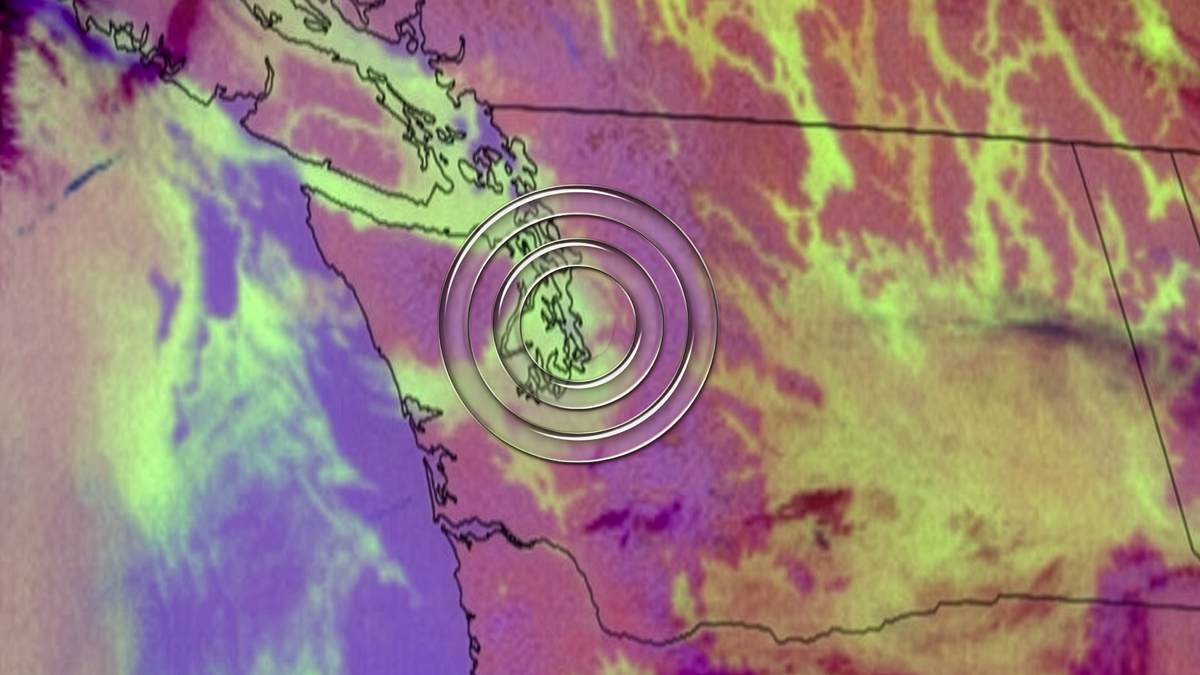
Fog covers the terminal airspace at Boeing Field, diminishing visibility.
Crisis inbound: When the fog forecast hits minimums
With four planes already inbound, the 1053Z METAR observation: half-mile visibility with an overcast cloud layer 200 feet above the ground.
ATC permitted the first aircraft to make an approach, and it descended through the fog layer to decision height. The pilot searched for runway lights that should have appeared through the mist — they weren’t visible.
The plane entered a low-level holding pattern, burning precious fuel with each orbit. After discussion with Flight Ops, the three other aircraft — which were minutes behind — were given a critical call: Hold at 25,000 to 28,000 feet.
This decision maximized their fuel endurance and bought time. The embedded meteorologist (MET) proceeded to find a solution that didn’t exist in any TAF.
A 50-mile wide cloud and a 20-minute chance
Concerns mounted about diverting all four aircraft and collapsing the entire operation. But the MET saw something in the satellite imagery.
Managers gathered urgently in the Meteorology office, and the briefing from the MET was direct. A narrow cloud deck, only 50 miles wide at 4,000 feet, was moving directly toward Boeing Field. This wasn’t speculation or probability ranges — this was observable atmospheric physics in motion.
Real-time weather intelligence from the world’s most accurate forecaster1 revealed a critical solution. The cloud would temporarily lift the fog deck, for perhaps 20 to 25 minutes. This one window was also the only chance to land all four aircraft on time.
Precision forecasting meets operational reality
The airline managers faced a decision with little to no safety net. Bring three aircraft down from holding altitude based on a 20-minute fog forecast window, or divert and accept that 30,000 customers would miss their service commitments.
They made the high-stakes call, pulling all three holding planes down to 10,000 feet. The cloud moved over Boeing Field exactly as forecast. The fog deck lifted, and all four aircraft landed within the window — one after another.
Then, just as the MET predicted, the cloud moved out. Fog returned immediately, dropping visibility back below minimums. It stayed that way until 17Z — five hours later.
Critical insights saving the day
Every inbound package made its service window. Crews stayed within duty limits. The 20,000 outbound packages departed on schedule. Thirty thousand customers received their deliveries because of a 20-minute forecast window that most meteorological products would never capture.
Without that hyper-specific guidance, the outcome writes itself: no inbound packages make service, crews time out, outbound operations collapse. The entire 30,000-customer chain breaks. Jeff Sarver, Meteorologist-In-Charge (MIC), The Weather Company, stated it clearly afterward: “The confidence level and demeanor of the meteorology team gave them the assurance they needed to make that high-stakes call. Not just the forecast — the confidence behind it, delivered by people who understood both the atmosphere and the operation it was about to disrupt.”
When weather intelligence matters: Confidence vs. the coin flip
Uncertainty makes aviation professionals uncomfortable. Pilots make tactical decisions in real-time with zero margin for error. But perfect forecasts don’t exist — a reality that creates tension between meteorological science and operational necessity.
Pilots make tactical decisions in real time with zero margin for error. But perfect automated forecasts don’t exist — a reality that creates tension between technology and operational necessity.
Consider the dreaded 50% probability (‘PROB 50’) forecast. Meteorologists see the challenge in issuing it, because it feels like a coin flip. But, context transforms that number completely. A 50% chance of freezing drizzle in Atlanta is alarming and operationally disruptive. But the same forecast in Minneapolis is just another winter day.
How confidence changes the game
This is where embedded meteorologists bridge the gap. At Boeing Field that morning, the fog forecast wasn’t about percentages — it was about a 50-mile-wide cloud deck arriving in 20 minutes. That specificity turned uncertainty into actionable intelligence.
Confidence doesn’t eliminate uncertainty. But it can help clarify what to do with it. Airlines with embedded meteorologists make more informed decisions than ever before, particularly when confidence is high in significantly disruptive events. This allows them to proactively cancel flights, reroute passenger connections, and position staff accordingly — sometimes days in advance.
The human element: Embedded expertise changes high-stakes decisions
Embedded meteorologists enhance communication capabilities in ways standard forecasts simply cannot. They discuss scenarios with dispatchers and operational managers, explaining not just the confidence level but the “why” behind it: timing windows, severity thresholds, geographic variability, and more.
One wrong decision coupled with vague intelligence can impact operations for the rest of the day, and domino fast. For example, one airline partner describes embedded meteorologists as their “early warning system.” They added, “A ‘PROB 30’ TAF entry, for example, isn’t enough information to make hub decisions.”
Transitioning from uncertainty to confidence — from “maybe” to “here’s your window” — produces outcomes that cascade through entire networks. That level of operational meteorology goes far beyond what any standard format, like a “PROB30” TAF entry, can communicate.
Let's talk
To learn more about our trusted, real-time aviation weather forecasts, contact our aviation experts today.
Contact us1 ForecastWatch, Global and Regional Weather Forecast Accuracy Overview, 2021-2024, commissioned by The Weather Company.
Key takeaways
- Cold, snowy weather makes people more emotionally open and sentimental, the perfect setup for impactful holiday advertising.
- Cold weather flips the brain into high gear, boosting emotion, and making memories stick.
- Gen Z’s profound connection to winter weather means holiday advertising that includes relevant weather feels more memorable.
- Tap into the season’s mood and watch ROI climb – winter-ready creative can boost performance by nearly 20%.
With the arrival of winter, the air turns cold, the days grow short, and heavy clouds prepare for snowfall. Wardrobes change from light jackets to heavy coats and sweaters. But that’s not all that’s changing. A new consumer neuroscience research study from Neuro-Insight reveals there’s also a predictable shift in the brain ignited by winter weather. We call this the Enduring Mindset, and it’s a critical lever for brands running holiday advertising campaigns.
Far from being a time to go dark with the early setting sun, the winter season is a prime opportunity for empathetic winter marketing campaigns that build lasting trust and drive conversions.
What is the Enduring Mindset?
The Enduring Mindset – one of four weather-driven mindsets – is triggered by cold, snowy weather or a wintry, rainy storm. The emotional effect is so strong that many of us are noticeably, consciously aware of its impact on our well-being.
When people experience this mix of winter weather conditions, several key brain systems go into overdrive: Emotional engagement, global memory, and imaginative thinking become more active. This heightened state fuels deeper emotional processing and a stronger appetite for meaningful content and connection.
In this mindset, consumers crave comfort, safety, and connection with friends and family. They’re also more sensitive and open to connections with brands that make them happier, remind them of fond memories, and help them connect with loved ones. This nostalgic, emotional state opens the door for brands to become part of the very magic that makes the winter holidays so special – and a powerful opportunity to introduce cold-weather marketing ideas that reflect how people actually feel.
Nostalgia marketing and consumer behavior
By leveraging holiday nostalgia and the Enduring Mindset in your holiday advertising strategies, you can help strengthen the brand-consumer connection by increasing the relevance and resonance of your message. The power of consumer neuroscience in marketing is undeniable: Ads that match the emotion can be more effective, improving ROI by nearly 20%.1
The impact of weather on nostalgia is particularly strong during the winter holidays:
- 53% of people say cold, snowy weather during the holiday season makes them feel nostalgic2
- 51% say the weather makes some of their holiday memories even stronger3
- 1 in 4 people say holiday advertising that includes relevant weather feels more memorable and impactful4
Key insight: Gen Z’s emotional connection to the holidays
Gen Z is even more likely than the general population to connect winter or holiday weather with their enjoyment of the season:
- 64% more likely to say it impacts their feelings of nostalgia or memories about the holidays5
- 65% say the weather makes some of their holiday memories even stronger6
- 62% say some of their happiest holiday memories are even better because of the weather7
As a result, 40% of Gen Z says holiday advertising that includes relevant weather feels more memorable.8 By understanding Gen Z’s profound emotional connection to winter weather, brands have a unique opportunity to build lasting relationships with this crucial audience.
Tactics to tap into the cold weather vibe
The Enduring Mindset is all about emotional sensitivity and desire for connection. What better way to create those connections than through heart-warming, holiday nostalgia? Meet consumers in the Enduring Mindset to drive:
- Brand affinity and loyalty
- Replenishment purchases for favorite products
- Repeated engagements
Here’s how to craft a holiday advertising campaign that resonates with consumers this winter season.
1. Lead with heart
Let empathy guide your messaging. Instead of a hard sell, create a narrative that makes your brand feel like a supportive companion during a difficult moment. This is a time for storytelling that evokes feelings of safety and nostalgia, not urgency.
2. Help check off to-dos
With all the excitement comes a little stress. People’s focus shifts to holiday prep, shopping and caring for others. Your brand can become a trusted resource by providing helpful, actionable content in the moment to bring comfort and peace of mind.
3. Embrace nostalgia
Familiarity boosts affinity. Choose visuals that evoke fond family memories of the season. Use a warm color palette that offers comfort from the cold, gray outdoors.
4. Show Gen-Z lots of love
Young people’s emotional centers are especially active right now. Match the emotion of your messaging to their mindset with Weather Targeting to build loyalty with this critical segment.
5) Use Weather Targeting to match the moment
Go beyond the forecast; anticipate the mood across all of your digital media activations. Weather Targeting is a targeting layer that uses AI to put your brand in front of consumers when they’re most receptive. As the world’s most accurate forecaster,9 The Weather Company helps you go beyond the calendar dates to identify the precise weather conditions that are scientifically proven to trigger the desire for warmth and connection. It’s this industry-leading precision that can help reduce media waste in your holiday advertising campaign, so you can target mindsets throughout the season, not just dates on the calendar.
Turn a seasonal shift into a strategic advantage
As the season changes, so does the brain. Winter makes us feel more, remember more, and connect more deeply – not just with people, but with the brands that understand us. The smartest winter marketing campaigns aren’t those that shout the loudest. They’re the ones that listen to the weather.
Let's talk
What’s your weather marketing strategy? To learn more about harnessing the power of weather to increase engagement and drive growth, contact our advertising experts today.
Contact us1 Impact of Weather study, Neuro-Insight on behalf of The Weather Company, April 2025. Metrics are based on calculations from the NI study and actual ROI metrics may vary.
2 3 4 5 6 7 8 TWC Holiday Consumer Behavior Survey, December 2024
9 ForecastWatch, Global and Regional Weather Forecast Accuracy Overview, 2021-2024, commissioned by The Weather Company
Key takeaways
- The Weather Company Aviation weather APIs help boost safety and enable smarter routing calls with sharper, high-resolution forecasts.
- The platform is built for enterprise-grade integration, offering low-latency, high-scale performance on a secure, cloud-native API architecture.
- The API catalog covers crucial aviation needs, from government-sourced Core data (METARs, TAFs) to proprietary Enroute forecasts (FIP, GTG3, HIWC).
- APIs are available in four distinct output types (Point-based JSON, Raster, Featurizer, and Tiler) for fast data delivery and seamless integration into custom tools.
- New APIs (Tiler Packed, Single Site Radar) enable 3D visualization, significantly reduce payload size, and deliver raw NEXRad Level II data for tactical decision-making.
- The Probabilistic API provides distribution graphs and scenario modeling for risk-based decisions, while the Historical Spatial API supports training and post-event analysis.
Modern airline operations demand access to weather data that supports every stakeholder – from dispatch to crew to passenger. Whether you’re focused on aviation weather flight planning, ramp safety, or customer alerts, the real question isn’t whether you need data. It’s how to integrate it securely, reliably, and at scale.
Aviation weather API solutions from The Weather Company are built for exactly that. Our platform delivers low-latency performance, scales across global airline networks, and follows a privacy-by-design model to meet enterprise-grade standards.
Choosing the right weather API integration for aviation teams
Operational complexity looks different at every airline. Some teams plug raw API feeds into dispatch tools and scheduling engines. Others rely on user-friendly platforms for visual workflows. Many fall somewhere in between.
The Weather Company offers one of the industry’s most comprehensive aviation data catalogs – with over 180 unique APIs across industries and more than 4,000 endpoints, all built on globally distributed, cloud-native API architecture.
of data ingested daily
API requests per day
Because our platform is built for weather in real time, all data is delivered with low latency and designed to integrate into custom workflows without compromising security or performance.
Comprehensive aviation weather API data packages
Supporting flight preparation and real-time situational awareness, our specialized Aviation weather APIs provide immediate access to the critical weather information airlines rely on. Cloud-based data packages are delivered via vector and raster APIs served from our Enterprise Data Platform. All APIs are REST-based and use GeoJSON responses.
The services below are grouped between fundamental government-sourced products, enhanced global and radar data, and proprietary, high-value enroute forecasts developed by The Weather Company.
- Aviation Core APIs: The Aviation Core package provides essential government-sourced, worldwide meteorological products. These include METARs and TAFs for surface conditions. The package also provides AIRMETs, SIGMETs for hazards (e.g., turbulence, icing), WAFS charts, PIREPs, and volcanic ash advisories from VAACs.
- Aviation Enhanced Core APIs: The Aviation Enhanced Core package delivers advanced, high-resolution data, including a current Forecast Radar Mosaic and a radar reflectivity forecast powered by The Weather Company’s Forecast on Demand system. This package also supplies Global Radar, NOWRad Echotops, RPM Echotops Global Forecasts, Global Ceiling Forecasts, and Temps and Winds Aloft Forecasts.
- Aviation Enroute APIs: The Aviation Enroute package delivers proprietary data from The Weather Company, the world’s most accurate forecaster.1 This includes our AIRMETs, SIGMETs and Flight Plan Guidance (FPGs). It also features forecasts for GTG3 Turbulence, Forecast Icing Potential, and HIWC (High Ice Water Content). Key products like FIP and GTG3 offer high-resolution (13-km) forecasts. They are available every 1000 feet from FL010 up to FL500, empowering planners with essential, frequently updated data for proactive risk management.
API output types: Fast data delivery and scalability
Our APIs can be deployed in application for mass consumption or into internal tools for distribution efficiency. Data can be delivered in one of four different types depending on the use case they’re serving:
- Point based: Gives a JSON payload for a specific point in space.
- Raster image: Returns PNG tile images that can be overlaid on top of maps.
- Featurizer: Allows you to draw lines or polygons over a map based on the specific thresholds that you set.
- Tiler: Provides the raw gridded output of data in tiles of 256 by 256 pixels to consume large amounts of data faster.
This versatility lets users select the exact format needed for optimal application performance, analysis, or visualization.
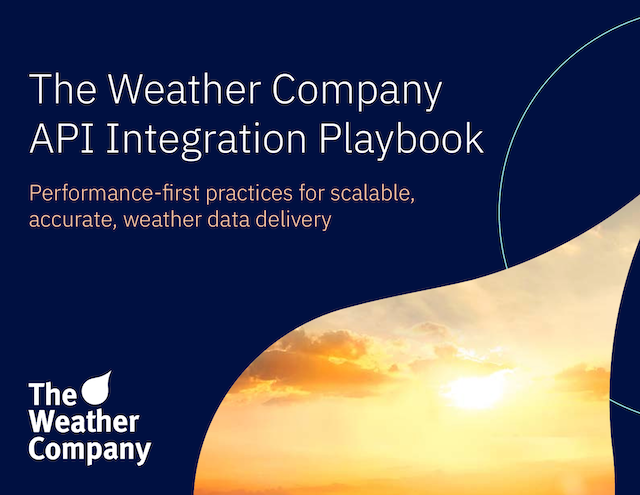
The Weather Company API Integration Playbook
Get your copyNext-Gen API architecture: Efficiency and advanced weather capabilities
At The Weather Company, we challenge ourselves daily to answer three key questions to enhance your experience:
- How do we deliver our products more efficiently?
- How do we enable new functionality and new use cases with our existing data?
- What new datasets or APIs can we deliver to open doors to whole new suites of tools?
The following new APIs represent a significant leap forward in how we package, access, and analyze meteorological data, delivering massive efficiency improvements while unlocking powerful new analytical and visualization capabilities.
Tiler Packed API
The Tiler Packed API is a reimagining and extension of how we deliver map tiles today. This API was carefully designed to enable next-generation data delivery, analysis, and visualization capabilities and powers some of the new features in The Weather Company applications.
It allows visualization of 50 flight levels of turbulence across North America in real time – streamed directly into 3D route engines with no unpacking delay. This structure reduces API request volume by up to 200x and shrinks payload size dramatically, making it easier to scale performance across large airline networks.
An airplane in flight in a 3D environment. This example uses the same mapping base that MaverickTM Dispatch uses and incorporates our turbulence index data.
Historical Spatial API
Post-event reviews and simulation training benefit from our Historical Spatial API, which lets teams replay actual weather conditions from past flights. Coming to Maverick Dispatch soon, this API recreates geo-specific weather at the time of ops decisions, which helps crews debrief and systems learn. Upcoming enhancements will add search functionality to help identify patterns or conditions with both qualitative and quantitative filters.
Single Site Radar API
In aviation, it’s not enough to look at a radar mosaic alone. Airlines need raw, high-resolution radar that pinpoints local risks and supports tactical decision-making. The Single Site Radar API delivers exactly that.
Rather than generalizing regional trends, this API gives teams access to NEXRad Level II and III data – complete with 3D volumetric rendering. It’s like having a private radar feed for your ops center, giving you the detail needed to spot severe weather before it affects your crew or airspace.
Multipoint (Enroute) API
The sophisticated Multipoint API efficiently provides Tiler product samples. You can query data either along a specified flight path or at a defined set of input points. This powerful API also incorporates crucial upsampling capabilities, allowing users to increase the resolution of an input path for finer detail. Specifically, when querying a Packed Flight Level product and providing altitude information, this API will intelligently return the appropriate flight level samples tailored precisely to the requested route.
Probabilistic API
Risk-based decisions depend on more than single-number forecasts. The Probabilistic API provides distribution graphs, percentiles, and full scenario modeling to help teams understand the range of possible outcomes.
Think of it like a forecasting confidence dashboard. You don’t just see what might happen. You see how likely it is, and what range to prepare for. It’s ideal for planning fuel reserves, rerouting thresholds, and even feeding ML models with full scenario sets.
The future of aviation weather tools: Our roadmap
The Weather Company’s aviation API roadmap continues to expand, shaped by feedback from our airline partners. Here’s a preview of what will be ready for takeoff soon:
- Live data notifications (currently in beta) will eliminate the need for frequent polling.
- More Tiler Packed datasets, open developer tools, and new ways to embed weather into both operational systems and the airline passenger experience are on the horizon.
- Easier developer onboarding and documentation
This commitment to continuous innovation means our aviation weather tools remain the most capable, scalable, and responsive solution for our airline partners.
Get started with an API free trial
Not sure where to begin? Whether your goal is to build custom solutions, augment existing platforms, or blend new data streams, we’ll help you choose the ideal Aviation weather API approach for your operation. Stop reacting to the weather and start controlling your outcome. Start your free API trial today.
Let's talk
To learn more about our advanced aviation weather solutions, contact our aviation experts today.
Contact us1 ForecastWatch, Global and Regional Weather Forecast Accuracy Overview, 2021-2024, commissioned by The Weather Company.
Key takeaways
- Integrated aviation solutions from The Weather Company can help drive safety, efficiency, and profitability across the entire airline operation.
- Flexible options include pre-built solutions, embedded meteorologists on site, and aviation APIs for custom builds and add-ons.
- The API catalog provides over 180 data feeds for low-latency, high-scale integration into any system.
- Weather intelligence is crucial across five core areas of the operation: passenger experience, strategic planning, flight planning and dispatch, ground and hub operations, and in-flight operations.
When a storm system develops over a major hub, the decisions made in the next 30 minutes determine the fate of the entire operation. Oftentimes, the challenge isn’t just the forecast itself. It’s getting accurate weather data and insights into the hands of flight operations, meteorologists, and crew making those decisions. Relying on static data or disconnected tools just won’t cut it. Airlines need dynamic intelligence integrated into every part of their workflow.
That’s why leading carriers like British Airways and Breeze Airways rely on aviation solutions from The Weather Company. We provide a complete ecosystem of data options to drive improvements across the entire airline operation.
Flexible intelligence for complex airline operations
Operational complexity looks different at every airline. Some teams rely on pre-built platforms for intelligence, while others want to extend or customize their own operational tools. With The Weather Company, airlines can tap into weather intelligence their way.
Ready-to-use platforms and expert services
For teams who want immediate value without starting from scratch, products like MaverickTM Dispatch and PilotbriefⓇ deliver full-featured aviation weather platforms built on the same API foundation. They offer intuitive interfaces, alerting, and rich visualizations right out of the box.
For operations requiring tailored human expertise, Weather Forecast Services provide expert support. Our embedded meteorologists partner with your dispatchers, ATC coordinators, and ops teams to turn complex data into clear, useful insights. They validate forecasts in real time and offer steady, expert guidance during critical weather events.
Aviation APIs: The engine powering custom tools
Our comprehensive catalog of aviation APIs fills the gaps and enhances the existing capabilities of modern airlines. With over 180 APIs covering every stage of the flight lifecycle, The Weather Company provides a deep API catalog of data to support every stage of airline operations, including:
- AIRMETs, SIGMETs, and PIREPs for airspace awareness
- Turbulence, icing potential, and ice water content for enroute risk mitigation
- TAFs and VAAC advisories for operational planning
- Global satellite, radar, surface analysis, and TFRs for situational awareness
- Forecasts tailored to altitude, route, or terminal zones
- Specialized inputs like solar irradiance, hub-height winds, and evapotranspiration
Our APIs deliver fast, real-time data to your systems, giving every tool – from the cockpit to the ground – the latest weather intelligence. Airlines maintain complete control over their user interface and workflow design, while relying on The Weather Company’s industry-leading data accuracy and robust, high-scale performance.
Driving results across the airline operations chain
The power of The Weather Company aviation solutions lies in our end-to-end coverage. By leveraging a mix of platforms, expert embedded forecasting services, and high-precision aviation API feeds, airlines can address five critical areas of operational focus:
 Passenger experience
Passenger experience
Enhance communication and manage passenger expectations. Use Aviation API forecasts and alerts to send real-time flight updates through your mobile app. These updates help reduce uncertainty, set clear expectations, and ease crowding at the gate during delays.
 Strategic planning
Strategic planning
Optimize long-term network and schedule profitability. With access to the Historical Spatial API and climatology data, teams can model future scenarios. This insight helps teams model fuel burn, test new routes, and adjust schedules around seasonal patterns. The result is a more efficient and profitable network over the long term.
 Flight planning and dispatch
Flight planning and dispatch
Create the safest, most efficient operational flight plan. Maverick Dispatch enhances route creation with visual overlays and advanced analysis tools. This process is powered by aviation APIs such as Multipoint (En Route), which automatically sample turbulence and wind along a flight path. It also leverages our Probabilistic API, which adds confidence bands and scenario modeling to help dispatchers make highly data-backed decisions – even minutes before takeoff. Dispatchers can also benefit from expert guidance through Weather Forecast Services. Embedded meteorologists help translate technical data from the APIs and other tools into actionable intelligence that guides confident decision-making in critical moments.

Ground and hub operations
Maximize on-time performance and ground crew safety by moving beyond generalized alerts. Monitor localized lightning and the most up-to-date precipitation data using the high-resolution Single Site Radar API. Airlines can subscribe to real-time updates and receive alerts the moment new data is published – no frequent polling required – helping to automate safety alerts and improve ramp safety protocols.
 In-flight operations
In-flight operations
Maintain airline safety and efficiency as conditions change. Pilotbrief gives pilots direct access to critical intelligence, including predictive turbulence forecasts and integrated in-flight radar. With this insight, they can reroute in real time to improve passenger comfort and reduce fuel use. This intelligence is supported on the ground by Maverick Dispatch, which assists with flight path changes. It’s also backed by expert Weather Forecast Services that constantly check and update aviation weather data. Pilots get the most current and reliable information they need to make confident decisions.
The ultimate advantage for airline operations
Whether you’re building new dispatch workflows or improving how your airline responds to real-time threats, The Weather Company delivers the most current aviation weather reports and forecasts to give your team a smarter, faster way to use weather as an advantage.
Ready to see what’s possible?
Explore our API catalog or start your free API trial today. You’ll see firsthand how aviation weather data becomes a decision engine when it’s delivered at the right time, in the right way.
Let's talk
To learn more about our advanced aviation weather solutions, contact our aviation experts today.
Contact usKey takeaways
- Accurate forecasting helps airlines anticipate airplane icing conditions and visibility limiting fog before they disrupt operations.
- Data-driven weather intelligence supports safer, more efficient flight planning across global airline networks.
- Advanced forecasting APIs deliver real-time updates that enhance operational readiness and minimize costly delays.
- Integrated weather solutions enable flight operations teams to maintain safety, schedule reliability, and cost efficiency in all conditions.
Every minute in aviation counts, and weather owns many of them. Small atmospheric changes can drive major operational costs. This includes airplane icing conditions that ground morning departures and dense fog that leads to diversions. These events can also disrupt flight schedules, increase fuel burn, and impact passenger safety.
As the world’s most accurate forecaster,1 The Weather Company helps airlines stay ahead. Tools like GRAFTM and outlook reports from Weather Forecast Services empower airlines to anticipate these evolving risks with the clarity and speed needed to plan with confidence rather than react under pressure.
Understanding the risks
Ice
Airplane icing conditions are a persistent threat to both flight performance and safety. While hazardous icing is less common for large commercial jets, even modest ice buildup can impact efficiency and safety. If not anticipated, ice accumulations can rapidly destabilize flight performance. NASA studies show this is because ice reduces lift by 30% and increases drag by 40%.2 As recently as 2024, ice formation was reported as a significant contributing factor in a crash resulting in 62 fatalities.3
On the ground, frost and freezing precipitation complicate ramp and deicing operations. Well-designed deicing facilities are central to safe winter operations. They integrate dedicated deicing pads, glycol collection systems, and fluid recovery infrastructure to streamline aircraft movement.4 These purpose-built areas allow multiple aircraft to be treated simultaneously while minimizing environmental impact and congestion near runways. As a result, airports and airlines that invest in modern deicing infrastructure enhance both safety and operational throughput when winter weather conditions intensify.
Fog
Fog is one of the most common and costly weather hazards in aviation, costing the aviation industry billions annually. A 2025 global review of fog and aviation research found that fog remains a leading cause of wintertime flight delays, prompting airports to invest in advanced forecasting and landing systems.5
Low visibility reduces runway throughput, slows taxi operations, and disrupts arrival sequencing during peak traffic periods. Recent machine learning studies have demonstrated significant gains in fog prediction accuracy, improving the ability to anticipate onset and dissipation times.6 With higher-resolution modeling and AI-driven forecasts, operational teams can adjust routing, scheduling, and ground coordination before visibility drops.
Proactive forecasting for safer, smarter decisions
The Weather Company equips aviation professionals with forecasting tools that go beyond traditional radar and model output. Each product translates complex data into actionable insights for flight operations and delivers decision-ready intelligence. This is achieved by combining high-resolution modeling with continuous aviation weather monitoring.
Visibility and fog forecasting tools
- WxMix™ (Weather Model Mixer): Analyzes more than 100 global weather models to pinpoint visibility drops before they impact operations.
- Human-Over-the-Loop™ (HOTL) intelligence: Refines AI-driven forecasts with expert meteorologist oversight for more accurate fog formation and dissipation timing.
- Forecasts On Demand™ (FOD) engine: Delivers real-time visibility updates by integrating multiple forecast sources for continuous operational awareness.

Icing forecasting tools
- Frost probability forecast: Indicates the likelihood of frost formation with risk tiers to guide pre-dawn de-icing and ramp operations.
- 3-day and 5-day international risk outlooks: Extends insight into regional icing trends, supporting global network operations and asset planning.
Together, these tools create an integrated operational forecasting ecosystem that supports continuous situational awareness for both convective and icing events. The Weather Company’s aviation icing forecast solutions give flight operations teams early insight into where and when frost, freezing rain, or ice buildup may affect aircraft performance and ground operations.
Data power: APIs that deliver accuracy and speed
Behind each Weather Company aviation product is a data infrastructure engineered for speed and security. Our optimized weather APIs allow organizations to access real-time decision support data at scale. We offer a comprehensive API portfolio designed to deliver the industry’s fastest, most reliable weather intelligence. This includes over 180 unique weather products and 4,000 endpoints, covering aviation, seasonal forecasts, lightning data, and more.
In aviation, where timing is critical, this difference matters. The Weather Company APIs deliver up-to-the-minute weather insights that enhance operational timing and reduce the cost of weather-related disruptions – helping airlines move from reactive to proactive management.
Purpose-built APIs for smarter aviation operations
Tiler Packed API technology reimagines raw gridded data delivery – reducing API call requests by up to 200 times for the same datasets. Packaging related layers – such as 50 flight levels of aviation weather data – into a single request improves data-transfer efficiency. This enables advanced visualizations like 3D icing potential or turbulence renderings.
Similarly, the Multi-Point API retrieves forecast conditions along a 3D flight path. It processes GeoJSON-compatible routes or waypoint sets and inspects all underlying gridded data, returning actual values in text format. Additionally, it offers optional downsampling to increase data frequency along the route.
This on-demand architecture helps dispatch systems, EFBs, flight-following tools, and other operational platforms receive continuously updated forecasts without redundant data calls. By aligning API requests with actual operational activity, such as flight plan updates or icing alerts, airlines minimize latency, reduce system load, and maintain situational precision.
Global scale and reliability
The scale behind this performance is equally impressive. The Weather Company platform ingests more than 500 terabytes of weather information every day and handles an average of two million requests per second, totaling 200 billion per day and six trillion per month. A 100% cloud-based, globally redundant infrastructure allows for greater resilience and continuous availability.
of weather information ingested each day
requests per second
Real-world impact: From forecast to flightline
Research consistently shows that weather is among the largest contributors to flight delays and operational costs. Flight delays and cancellations cost the U.S. economy roughly $30 billion to $34 billion in 2022 alone.7 This reflects lost productivity, additional airline expenses, and broader economic ripple effects. By integrating The Weather Company’s tools and APIs, airlines can mitigate many of these losses through early detection, adaptive routing, and coordinated response.
In practical terms, these forecasting innovations allow flight operations teams to:
- Identify high-risk airplane icing conditions before they form.
- Anticipate fog formation that could delay or reroute flights.
- Optimize de-icing resource allocation to minimize idle time.
- Improve coordination between dispatch, ATC, and ground crews.
The result is not only enhanced safety but measurable operational efficiency – where fewer delays, reduced fuel consumption, and smarter asset utilization directly impact the bottom line.
Operate confidently in any condition
The Weather Company’s aviation solutions unite scientific rigor, high-performance data infrastructure, and proven accuracy to help operations teams prepare for every scenario. From predicting airplane icing conditions to analyzing fog outlooks, these tools empower airlines to stay ahead of weather, not behind it.
Talk to a Weather Company expert to learn how integrating these forecasting and API-driven insights can strengthen your operational readiness and help your airline operate confidently – no matter what the atmosphere delivers.
Let's talk
To learn more about our advanced aviation weather solutions, contact our aviation experts today.
Contact us1 ForecastWatch, Global and Regional Weather Forecast Accuracy Overview, 2021-2024, commissioned by The Weather Company.
2 National Aeronautics and Space Administration (NASA), Aircraft Icing Research at NASA Glenn Research Center, 2013.
3 NPR, Cockpit audio indicates issues with de-icing in deadly Brazil plane crash, 2024.
4 Federal Aviation Administration, Advisory Circular 150/5300-14D: Design of Aircraft Deicing Facilities, 2020.
5 Springer Nature, Fog and Global Aviation: The State of Knowledge Evolution, 2025.
6 Atmospheric Research, Efficient prediction of fog-related low-visibility events with Machine Learning and evolutionary algorithms, 2023.
7 U.S. Department of Transportation and AirHelp, Cost of Disrupted Flights to the Economy, 2024.
Key takeaways
- The Weather Company’s embedded meteorologists solve the “translation problem,” turning complex weather data into actionable intelligence where standard aviation products fail.
- The O’Hare case study demonstrates how a Next Day Convective Outlook gives operations up to 24 hours for proactive planning (diversions, cancellations, etc.).
- Embedded METs work with dispatchers and ATC to provide hour-by-hour impact forecasts and use tools like GRAFTM for real-time validation and high operational confidence.
- This approach shifts airline operations from “reaction mode” to “control,” successfully mitigating the dual disruption of thunderstorms and ATC restrictions.
Your airline is drowning in weather data, yet thunderstorm disruption continues to paralyze your network. Standard aviation products – TAFs, TCFs, and broad outlooks — fail when you need them most. They can’t keep pace with rapidly developing storms that move erratically and create highly localized impacts. This isn’t a forecasting problem; it’s a translation problem.
Without a dedicated aviation meteorologist, conflicting weather model data becomes noise rather than split-second, actionable intelligence. Your operations get stuck in “reaction mode” instead of staying ahead of conditions. Even perfect forecasts are often derailed by unexpected ATC programs and route restrictions. The collaboration needed to mitigate weather, ATC, and other unexpected operational burdens is key to keeping an airline’s operation intact.
It’s time to stop reacting to the sky and start controlling the outcome from the inside out. This is why The Weather Company embeds meteorologists — as part of FAA-compliant EWINS Weather Forecast Services — directly in airline operations centers. They work side-by-side with dispatchers and dispatch specialists that communicate directly with air traffic control. Together, they turn thunderstorm uncertainty into operational confidence through early planning, real-time collaboration, and proactive communication.
A summer 2025 storm event at Chicago O’Hare (KORD) illustrates how this works.
Case study: Chicago O’Hare and the 24-hour convective outlook advantage
Managing a thunderstorm event begins well before the first cell appears on radar. Consider a typical warm-season scenario. On a Sunday evening, embedded meteorologists (METs) identified a potential thunderstorm for Chicago O’Hare coming Monday afternoon.
Rather than waiting for morning briefings, the METs produced a Next Day Convective Outlook, helping the airline start the planning process for what would become a major convective disruption at one of North America’s busiest hubs.
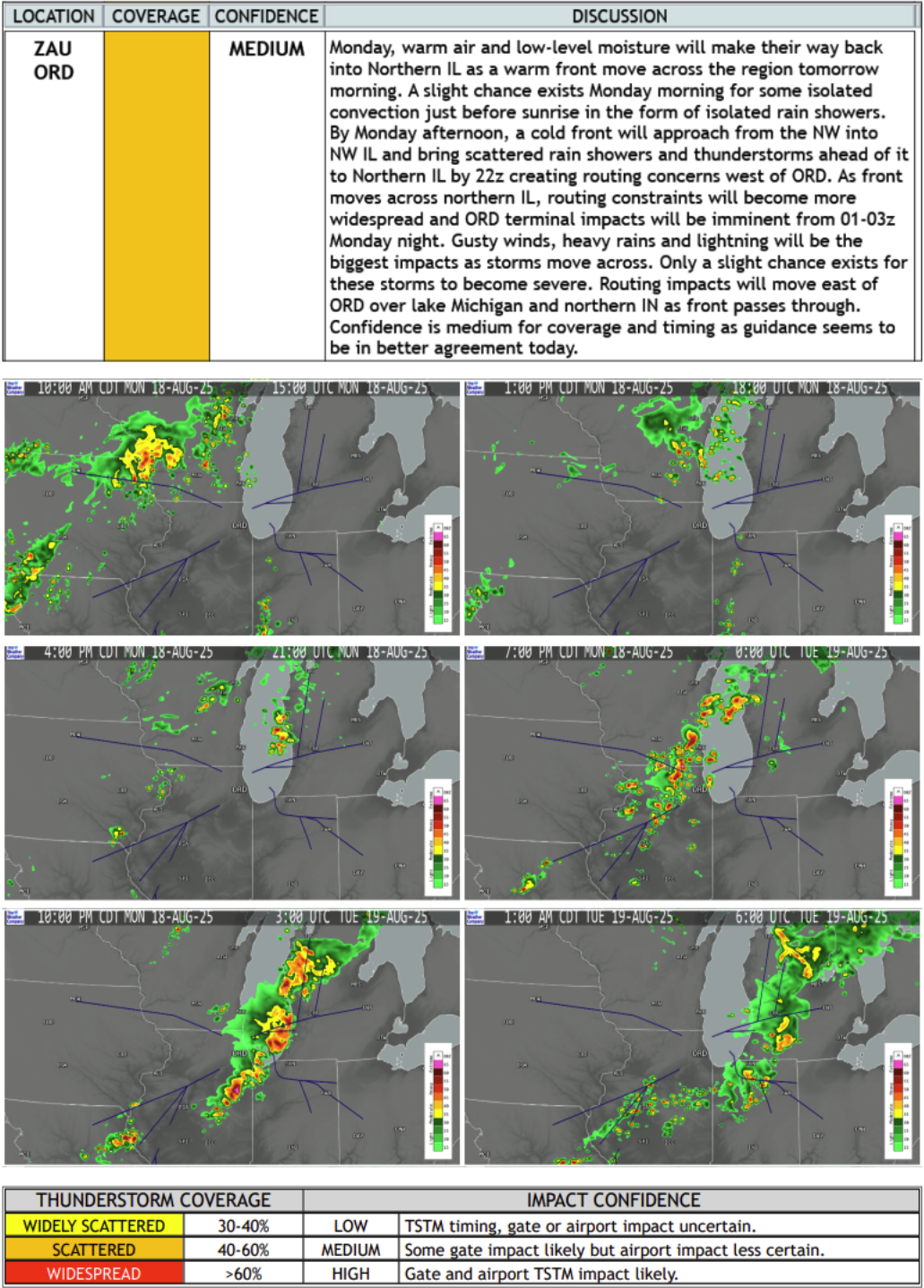
Next-day convective outlooks are issued when significant thunderstorms are forecast at an airline hub or over a critical route.
For operations, these early outlooks:
Allow lead time for planning: With ~24 hours to prepare, operations teams have time to identify diversion stations outside the threat area. It also allows for cancellation and thunderstorm flight delay strategies based on expected severity and timing. Proactive forecasts often trigger airline policy changes. This allows passengers to change flights, without penalty, to avoid severely impacted weather regions or time periods.
Enable proactive, tactical decision making: The O’Hare outlook flagged potential Sunday afternoon thunderstorm impacts, giving meteorologists and decision-makers a full-day head start. Forecast radar representation, storm evolution discussions, and confidence assessments fill gaps that Terminal Aerodrome Forecasts (TAFs) miss. This proves critical when thunderstorms can intensify or dissipate within hours.
Initiate NAS coordination: Storm impacts at major hubs like O’Hare ripple across the National Airspace System (NAS). The Sunday outlook initiated discussions between the airline and the FAA for Monday operations. The airline’s perspective was heard early when planning for potential convective disruptions.
Proactive coordination: Refining the forecast with embedded aviation meteorologists
As Monday morning arrived and the Chicago thunderstorm moved closer, the urgency intensified. Tactical forecasts like Consolidated Storm Prediction for Aviation (CoSPA) and Traffic Flow Management Convective Forecasts (TCFs) often don’t capture the complete flights and thunderstorm impact window. But, embedded METs can provide hour-by-hour convective impact forecasts — tracking airport conditions and thunderstorm threats along arrival and departure corridors.
In the case of O’Hare, TAFs may describe Chicago airport weather, but they didn’t tell the full story. Thunderstorms will impact arrival and departure gates around the airport. Likewise, the direct terminal area will be impacted during peak afternoon operations.
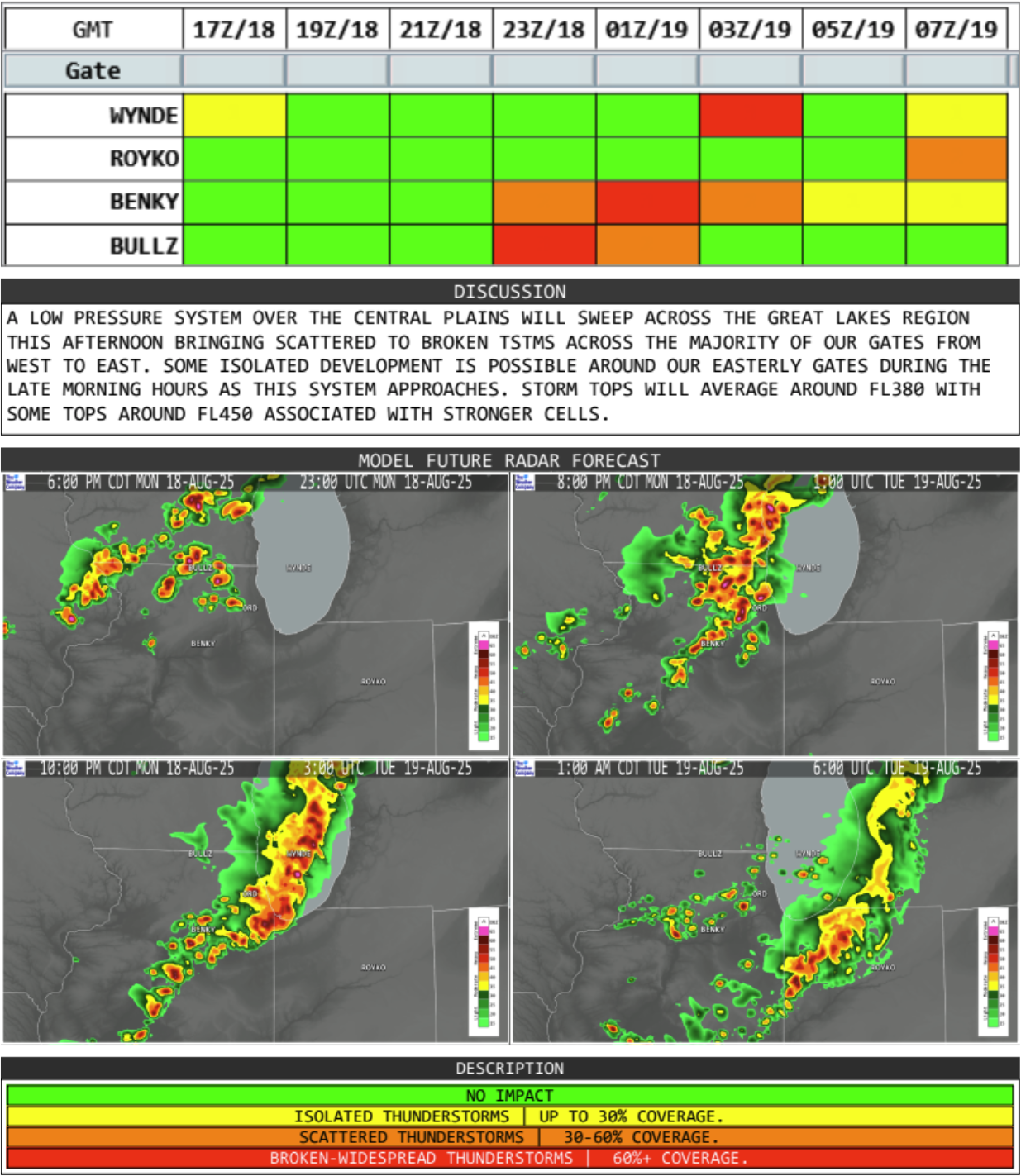
The Convective Gate Forecast identifies how each arrival gate will be affected by incoming thunderstorms, helping ATC groups plan for traffic flow adjustments.
Real-time intelligence: Navigating the convective threat window
The Weather Company embedded METs receive TCF output 30 to 45 minutes before official publication with real-time validation from the world’s most accurate forecaster.1 Armed with this intelligence, they can join chat channels and whiteboard collaborations around forecasts.
In this scenario, they provided ground-truth perspective on O’Hare flights and thunderstorm timing, expected coverage, and movement to ATC coordinators, leadership, and airport operations teams. At this stage, the METs can challenge or validate proposed convective outlooks. They base this on real-time analysis — helping to align the Chicago forecast with the actual thunderstorm threat. And critically, keep everyone on the same page.
Split-second decisions powered by high-resolution data
Constant analysis can separate anticipation from reaction. At O’Hare, embedded METs gave decision-makers the intelligence to act by providing real-time insights into thunderstorm behavior. Traffic usually accelerates ahead of an approaching storm line. Arrivals slow when cells intensified faster than expected. As cells developed at O’Hare, The Weather Company’s Global High-Resolution Atmospheric Forecasting System (GRAFTM) forecast radar and live lightning analysis helped visualize the thunderstorm’s structure, movement, and intensity. These tools helped embedded METs communicate exactly where convective threats exist and when windows of opportunity will open. Fortunately, this is context that wind speeds and precipitation amounts alone cannot convey.
These tools support collaborative decisions, led by embedded meteorologists, to help the airline understand when terminal and enroute storm impacts will abate. They also guide when ramp operations can return to normal or when post-thunderstorm winds reverse the runway configuration, and more.
Post-event review: Turning disruption into operational learning
Thunderstorms obviously don’t follow scripts. That’s why post-event analysis matters. It’s time for the embedded METs to examine and understand what the thunderstorm did versus what was expected. This analysis helps sharpen forecast decision making and improve operational readiness for what’s ahead.
After this thunderstorm event produced delays and diversions, the METs reviewed outcomes directly with airline teams. These reviews aren’t punitive; they’re opportunities to refine approaches for the next convective event rolling through the Chicago area and beyond.
From convective uncertainty to operational confidence
The Chicago O’Hare case demonstrates that thunderstorms are inherently volatile and uncertain, but your team’s response can be rooted in confidence.
Embedded meteorologists do more than forecast thunderstorms — they translate complex weather patterns into clear, timely, and actionable intelligence. Whether it’s Chicago O’Hare or any hub in your network, our embedded METs can help you stay ahead of the storm so you’re never caught off guard.
Let's talk
To learn more about how The Weather Company’s embedded meteorologist services can support your airline operations center, contact an aviation expert today.
Contact us1 ForecastWatch, Global and Regional Weather Forecast Accuracy Overview, 2021-2024, commissioned by The Weather Company
Key takeaways
- The future of TV is no longer tied to the living room – it’s wherever your audience is watching.
- From AI to cloud tools, broadcasting technology trends are making storytelling faster, smarter, and more flexible.
- Viewers still turn to local meteorologists when it matters most, even in a digital-first world.
- Hispanic audiences are shaping the next era of content with their strong presence on streaming and mobile platforms.
As more viewers turn to digital platforms for news and content, TV broadcasting is changing fast to stay relevant in a mobile, on-demand world. The next chapter of the future of TV belongs to those who can blend emerging broadcasting technology trends with what has always made television essential: accurate information, local trust, and timely delivery.
1) From linear decline to digital-first dominance
Audiences are continuing to shift toward digital platforms – and the data is clear. According to Nielsen, streaming accounted for 44.8% of U.S. TV viewing in May 2025,1 slightly surpassing combined linear TV (broadcast + cable), which fell to 44.2%. This marks a symbolic turning point: For the first time, digital viewing has eclipsed traditional TV on the biggest screen in the home.
Meanwhile, more than 77% of the U.S. population is forecast to watch OTT video in 2025,2 according to eMarketer. That figure includes YouTube, free ad-supported TV (FAST), and subscription services, reflecting the growing momentum toward digital-first platforms.
Broadcasters are no longer just TV stations – they’re evolving into multi-platform media organizations. From mobile apps to TikTok to 24/7 streaming news services like CBS News Boston, the industry is reorienting around where viewers actually are.
And this is just the beginning. Linear TV’s share of video time on TV screens dropped from 72.2% in 2020 to just 56.5% by the end of 20243 – a dramatic shift in just four years.
“The most successful media outlets will be those that can deliver accurate, local, and up-to-the-minute updates,” says Terry Eliasen of WBZ-TV. That means building the infrastructure for streaming, mobile, and real-time content delivery.
Within the next few years, digital-first workflows will lead, and linear TV will be viewed more as a supplement.
2) Immersive tech: AR/VR and the rise of the virtual studio
Gone are the days of elaborate physical sets. Many newsrooms are now green-screen studios powered by AR/VR tools that create virtual environments with a few keystrokes. This shift has enabled dynamic storytelling, especially in weather coverage. Smaller-market stations are often down a person, with larger station meteorologists filling in – where storm systems can appear beside the presenter in real time.
Many broadcasters now have the ability to transform their entire look with just a few keystrokes, thanks to virtual sets and AR/VR tools. But there’s growing concern that too much visual spectacle can distract from the core mission. While immersive graphics enhance storytelling, the priority must remain on delivering essential information.
“We must be certain that we still are delivering the information that people need and not just giving them eye candy,” Eliasen cautions. Smaller-market stations are often down a person, with larger station meteorologists filling in, rather than just high-tech visuals. Despite having instant access to forecasts via mobile apps, viewers still rely on their local TV meteorologists when safety is on the line.
3) AI in broadcasting: Automation, personalization, and precision
Artificial intelligence has become the engine room of modern broadcasting. AI now supports:
- Automating newsroom workflows
- Generating real-time weather models and graphics
- Localizing content for individual viewers
- Powering voice-activated tools in studios
At The Weather Company, AI-enhanced forecasts integrate over 100 data models in real time, personalized for every location, moment, and platform.
“As we all know, AI has so many layers and possible uses,” says Lelan Statom, Senior Meteorologist at News Channel 5 Nashville. “We use it with our voice-activated prompter in the studio. For weather, it’s already being used to produce models and help improve workflows.”
4) Expanding Hispanic audiences and content localization
The rapid growth of Hispanic digital audiences is shaping the future of broadcast television. This demographic leads in streaming adoption and digital media consumption, prompting networks to invest in bilingual content and AI-driven translation tools.
“Over the next few years, the television industry will be profoundly transformed by the convergence of AI, the growing influence of the Hispanic market, and advances in meteorology,” says Albert Martinez, founder of Canal Meteo. “Spanish-language content and digital platforms will be critical as viewing preferences shift.”
5) The cloud era: Collaborative production, streamlined workflows
Cloud-based production is now central to broadcast operations. Centralized graphics systems and shared storage environments allow for:
- Real-time collaboration across markets
- Streamlined branding
- Faster content updates
But there are downsides. “Broadcasters will deepen their reliance on cloud storage and shared graphic spaces… but [this] will also be used to forestall hiring decisions,” warns Brandon Butcher. “Smaller-market stations are often down a person, with larger station meteorologists filling in – unpaid”.
That pressure is felt daily in the field. “While there may be a variety of new features broadcast groups are rolling out in their apps and streaming platforms, the bottom line remains meteorologists have to do more with less time,” notes Betsy Kling, Chief Meteorologist and Anchor at WKYC-TV. “This means finding ways to multitask and leverage technology. Thinking outside the box and devoting time to deepen knowledge of our weather systems is key.”
The challenge for 2026? Balancing broadcast media innovation with human bandwidth and local authenticity.
6) The rise of independent meteorologists and new monetization paths
The broadcast media vs. digital media conversation isn’t just about networks. More meteorologists are leveraging technology at home to launch their own YouTube channels, livestreams, and subchannels – reaching loyal audiences directly and keeping the profits.

Brandon Butcher forecasts a future where “individual meteorologists…realize they are the face of the revenue stream and audience relationship” and may break away to build solo brands. “The early adopters will be successful, claiming large territorial markets, but as more jump in, competition will shrink the pie.”
7) Trust, accuracy, and the power of local connection
In a media world full of noise, one thing hasn’t changed: Accurate, local content still wins.
Tools like The Weather Company’s Max Engage allow broadcasters to push content across TV, mobile, and social simultaneously. “There are few programs that allow for multi-platform distribution with one click,” says Jordan Evans of ABC7. “Max is ahead of the game with its Engage and Social products.”
And in markets where real-time alerts save lives, the value is even clearer: “Max Engage allows us to quickly and effectively deliver life-saving alerts…while maintaining uninterrupted on-air coverage,” says Danielle Breezy from WKRN-TV.
Looking ahead: Broadcasting in 2026 and beyond
The future of the television industry will be defined by how well broadcasters balance technology with trust. As AI, AR/VR, and cloud production reshape workflows, success will belong to those who:
- Stay digital-first
- Serve diverse, mobile audiences
- Prioritize real-time, accurate forecasting
- Maintain deep community relevance
In other words, the networks that thrive will not just keep up with television trends; they’ll shape them.
The Weather Company, as the world’s most accurate forecaster,4 is helping broadcasters lead this transformation – bridging next-gen technology with the trust that local audiences rely on.
Let's talk
To learn more about our professional weather and traffic software solutions for the media industry, contact our media experts today.
Contact us1 Nielsen, Streaming Reaches Historic TV Milestone, Eclipses Combined Broadcast and Cable Viewing for First Time, June 2025.
2 eMarketer, US OTT, Pay TV, and YouTube Viewers Forecast 2025, May 2025.
3 eMarketer, Video Evolution: Linear Decline Makes Way for Livestreaming, January 2025.
4 ForecastWatch, Global and Regional Weather Forecast Accuracy Overview, 2021-2024, commissioned by The Weather Company
Key takeaways
- On-site airline meteorologists provide real-time, high-confidence weather intelligence, working directly with airline dispatchers and ATC coordinators.
- During Hurricane Helene (Category 4), this airline-meteorologist partnership enabled airlines to determine precise, safe closure and reopening times, minimizing costly, system-wide disruptions.
- Embedded flight meteorology expertise from The Weather Company successfully mitigated unexpected challenges, including reduced operations at hubs like Charlotte (200 miles away) due to the hurricane’s extensive wind field.
- Consistent communication with the National Weather Service (NWS) and CWSU supports forecast alignment for hurricanes and flights, providing airlines with the unified information needed for confident operational planning.
When severe weather threatens flight operations, delayed or imprecise decision making can put safety, profitability, and system efficiency on the line. To achieve operational certainty, major airlines rely on The Weather Company’s FAA EWINS-compliant Weather Forecast Services. We provide embedded meteorologists that work shoulder-to-shoulder with dispatchers, ATC coordinators, and key decision makers, offering real-time, hyper-local guidance that a broad forecast simply can’t match.
This close, dedicated partnership is never more critical than when extreme weather threatens the grid — as was the case with Hurricane Helene.
Navigating Hurricane Helene
In September 2024, Hurricane Helene made landfall as a major Category 4 hurricane across Florida’s Big Bend, impacting major airline hubs in its path. When a major hurricane like Helene makes its way through the Southeast, it’s not just the coastal cities that feel the impact – the decision-making ripple effect can ground flights hundreds of miles away.
Our embedded meteorologists are seasoned in the nuanced forecast needs of airlines during storms like Helene. For airlines to maintain both airline safety measures and operational fluidity, they need more than a general forecast; they need real-time, targeted intelligence from experts who know their specific operation.
As one of our airline Meteorologist-in-Charge (MIC) experts, Hannah Cohn, put it, “We are an integral part of things now. Our embedded meteorologists transition from operational support to crisis management, offering a unique blend of active monitoring, proactive counsel, and reactive solutions.”
The proactive approach to a Category 4 storm
The most intense, hurricane-force wind impacts are often a foregone conclusion for a few stations – they must close for safety. Our embedded meteorologists guide the airline to determine when those stations need to be closed and help position staff, flight attendants, and pilots out of harm’s way.
However, the strategic value during a major storm is in managing what lies beyond. “We’re really not looking at the eye of the storm… we’re more looking at the outskirts of the storm, the periphery of the storm,” says Hannah. “The ones that are on the thresholds.”
These are the stations getting 30-35 knot gusts, potentially up to 40. Such wind speeds can still allow for operations, depending on direction and runway configuration, but they are right on the edge. This is where a subtle, tailored forecast makes the difference between an unnecessary system-wide disruption and a safe, minimized operational reduction.
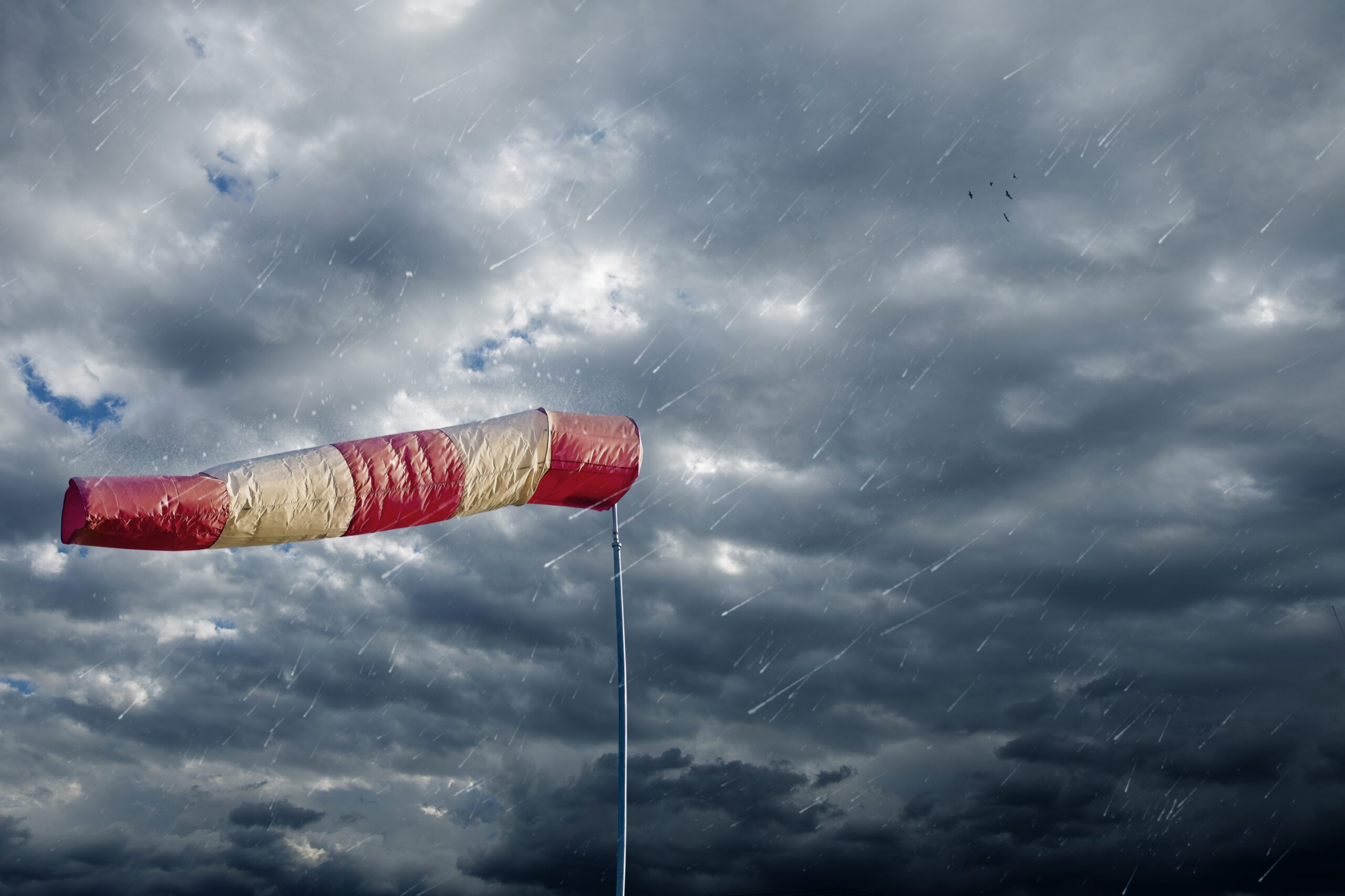
Winds near the hurricane’s edge strain operations and test safety limits.
Communication: The core of the strategy
Support is proactive, beginning up to 48-72 hours before a landfall event. The embedded meteorologist’s role during a storm like Helene means airlines are receiving consistent, clear communication and collaboration 24/7. Our teams:
- Issue detailed tropical tables: These intelligence packages — updated four times a day — provide storm forecasts, including wind tables, rainfall amounts (for flood risk), and come with detailed discussions on forecast confidence.
- Provide confidence: As our airline meteorologists engage with ATC coordinators, dispatchers, and key decision makers, conveying a high level of confidence in the forecast accuracy is critical to reinforcing their operational plan.
- Sync internal and external partners: We engage in constant chat and conference calls (three to four times daily) with the airline’s operational leaders to align all parties on evolving forecast conditions throughout the event. We also collaborate with the National Weather Service (NWS), and Center Weather Service Units (CWSU) to avoid a scenario where the airline is getting conflicting information, making their already tough decisions impossible.
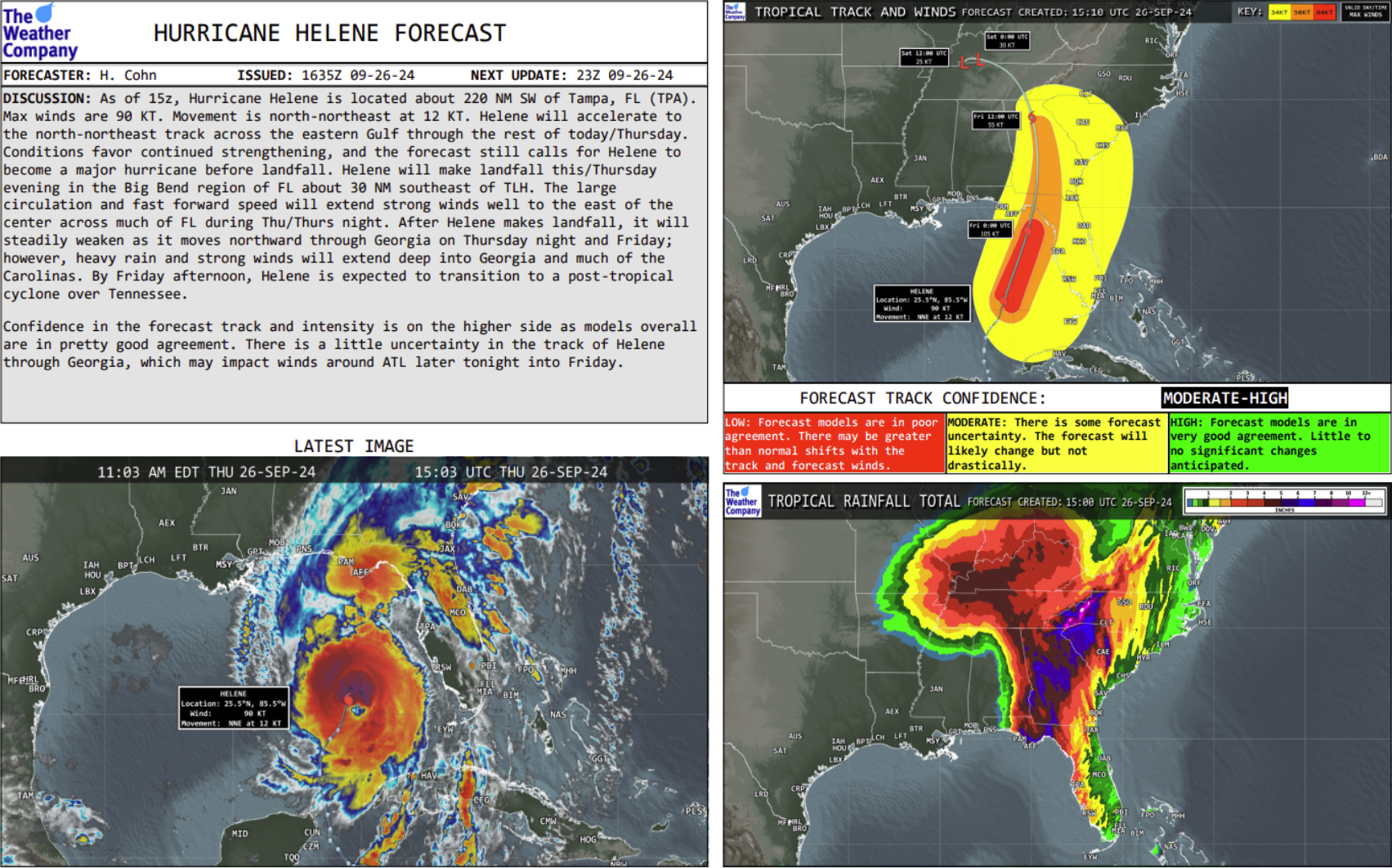
A clear and concise summary of the storm’s current state and its anticipated impacts.
The ripple effect: Beyond the eye of the storm
One of the most telling examples from Hurricane Helene wasn’t a station directly hit, but a major hub hundreds of miles away. Helene tracked 200 nautical miles west of Charlotte (CLT), yet the hub still had to significantly reduce operations. The extensive wind field created strong crosswinds — gusting up to 50 knots from the east-southeast — that made landings and takeoffs unsafe or impossible on many runways.
Our embedded meteorologists worked side-by-side with the ATC coordinators, helping the airline:
- Determine the rate: Collaborating on when to reduce the arrival and departure rate into Charlotte.
- Guide cancellations: Advising on the necessity of cancellations to clear the backlog and maintain airline safety measures.
- Support recovery: Immediately shifting focus to helping the airline get their operation safely back up and running once the winds subsided.
Forecasters and operational partners
Embedded airline meteorologists offer on-the-ground collaboration that mass-market forecasts can’t provide. It’s about solving problems on the fly and helping enable maximum safety with minimal economic impact. We become integral members of your operations teams, not just weather consultants, here to help you weather any storm.
Let's talk
To learn more about how The Weather Company’s embedded meteorologist services can support your airline operations center, contact an aviation expert today.
Contact usKey takeaways
- The Weather Company believes in the power of client collaboration to continuously improve our technology.
- The proprietary Global Resolution Atmospheric Forecasting (GRAFTM) system updates hourly and provides high-resolution forecasts down to 4 kilometers, enabling prediction of small-scale events like thunderstorms.
- Collaborative GRAF task force meetings turn client reports from real-world scenarios into tangible fixes and model enhancements.
- Client input has led to notable, specific enhancements, including better prediction of wind gusts in Southern California, improved visibility forecasts in Louisiana, and corrected snowfall parameters in the Columbia River Basin.
For decades, advancements in weather forecasting have been driven by increasingly sophisticated technology and the relentless pursuit of more accurate data. But at The Weather Company, we’ve found that the most powerful engine for progress isn’t just technology – it’s people. Specifically, a dedicated group of meteorologists and scientists who have been meeting monthly for the past four years to refine and enhance the Global Resolution Atmospheric Forecasting (GRAF) modeling system.
But first, a closer look at GRAF.
What is GRAF? High-resolution atmospheric forecasting explained
The GRAF modeling system is a proprietary, physics-based, high-resolution, rapidly updating global weather forecasting system. Unlike conventional global models that update every six or more hours and operate at a resolution too wide to capture many weather phenomena, GRAF updates hourly and offers high-resolution forecasts down to 4 kilometers. This enables it to predict something as small as a thunderstorm, making it a critical tool for everything from daily planning to severe weather preparedness.
Behind the forecast: The GRAF task force in action
This isn’t your typical corporate task force. The GRAF team is a dynamic forum where The Weather Company technical experts, who build and maintain the model, directly engage with clients around the country who use it every single day on the front lines of forecasting. This collaborative approach has become a cornerstone of our commitment to excellence, so that the weather model data we provide meets the real-world needs of broadcast meteorologists, news stations, and, most importantly, the communities they serve.
In a recent meeting, the conversation covered everything from the finer points of radiational cooling to the nuances of tropical storm modeling. Friendly dialog is based on mutual respect and candid feedback. The Weather Company weather science team shares what they’re working on and what challenges they’re facing, while clients offer crucial, boots-on-the-ground insights as they work with GRAF data in their Max platform.
Direct impact: How client feedback shapes our technology
This unique and collaborative partnership is truly a “two-way street.” It’s not about top-down directives; it’s a living dialogue where every piece of feedback, whether a bug report or a suggestion for a new parameter, is heard and considered.
Our clients’ input is invaluable. They are the ones seeing how GRAF performs in a wide variety of real-world scenarios, from snow in Portland to tornadoes in Mississippi. This direct feedback loop results in targeted improvements which – along with our advanced models, techniques, and meteorological expertise – helps secure our title as the world’s most accurate forecaster.¹
From report to resolution
The results of this collaboration are already evident. Task force members have seen firsthand how their feedback has led to direct improvements in the model. Patrick Bigbie, a meteorologist and task force member, recalled a specific instance where a bug in an ice parameter was fixed after he reported it. “There was a very noted difference once he put in the correction for it,” he said.
Another member, Mark Nelsen, a broadcast meteorologist in Portland, Oregon, shared how the group’s discussions helped him understand why a snow forecast was too high during a specific event. “The model was actually seeing ice pellets, too,” Nelsen explained. “I was able to spread that around and put it in my blog so others in Portland would be aware of that too.” This kind of information sharing extends beyond the meeting, directly benefiting a broader audience.
In addition, notable enhancements have also included:
- Improvements to the forecasting of shallow cold air and snowfall across the Columbia River Basin. Other models were picking up on upcoming snowfall in that area up to a few days faster than GRAF. Using The Weather Company’s lab environment of high-performance compute resources, a few weeks of research and development allowed for improvements to the PBL and orographic wave drag physics. These changes had a positive impact not only for the Columbia River Basin, but also across other parts of GRAF’s global domain. This was a great example of one GRAF user’s observation impacting GRAF development beyond a local use case.
- Better prediction of wind gusts across southern California. The GRAF model had overpredicted wind speeds in that area by as much as 40 mph at certain times. The Weather Company added new wind gust algorithms that significantly improved GRAF’s wind gust forecasts.
- Improvements to visibility forecasts across Louisiana. GRAF’s forecast visibility was too low during radiational cooling events. The Weather Company implemented new algorithms and improved the visibility product across a wide range of atmospheric conditions.
- Better prediction of freezing rain and snowfall across Mississippi. GRAF users reported excessive freezing rain and snow forecasts. This was quickly resolved in three days with land surface model updates.
More than a meeting: A commitment to continuous improvement
These exchanges are not just about fixing problems – they’re about innovating and looking ahead. The team is consistently exploring how to incorporate new data, new visualization capabilities, and new forecast parameters that make the product more useful and powerful. The conversation often touches on emerging technologies like AI and machine learning to keep the GRAF modeling system evolving with the industry.
“It’s a testament to our team’s deep commitment to customer-centric innovation,” said Sheri Bachstein, President of The Weather Company. “By bridging the gap between our weather science experts and the broadcast meteorologists who rely on our products daily, we are not only building more robust and reliable forecasting tools but also fostering a community of shared knowledge and continuous improvement. This collaboration is a core part of our continued efforts to deliver the most trusted and reliable weather information in the world.”
Innovating through shared expertise
In a world where weather events are becoming more frequent and more severe, the need for accurate, timely, and hyper-local forecasts has never been greater. The GRAF task force is a testament to how the best technology is only as good as the collaboration behind it. By empowering our clients to be partners in our product’s evolution, we’re not just building a better model – we’re helping to create a safer, more informed world.
Let's talk
To learn more about our professional weather and traffic software solutions for the media industry, contact our media experts today.
Contact us1 ForecastWatch, Global and Regional Weather Forecast Accuracy Overview, 2021-2024, commissioned by The Weather Company
Key takeaways
- Weather-based advertising powered by Weather Targeting delivers privacy-forward personalization by connecting campaigns to real-world conditions.
- The influence of weather shapes audience mood, behaviors, and purchase intent, giving marketers a powerful contextual advantage.
- Hyperlocal weather data equips brands to anticipate demand and adapt campaigns with precision at the ZIP code level.
- Weather-activated ads demonstrate contextual advertising effectiveness across CTV, retail media networks, and programmatic platforms.
What if the most influential marketing signal isn’t hidden in a dashboard, but right outside your window? For years, marketers have optimized for content, time of day, and audience segments. But they’ve been missing the one lever that truly moves the needle: the weather. Weather-based advertising powered by Weather Targeting can transform real-world weather conditions into a marketing superpower. It’s a strategy that delivers context, relevance, scale, and, most importantly, measurable ROI for your campaigns.
What is Weather Targeting?
As data privacy regulations fluctuate and consumer expectations shift, brands are searching for ways to deliver relevance without surveillance. At its core, Weather Targeting is an innovative, privacy-forward strategy that leverages hyperlocal weather data to anticipate human (and consumer) behavior. Instead of relying on identifiers or third-party cookies, Weather Targeting uses AI to personalize and contextualize ad delivery based on real-time and forecasted weather.
By tapping into environmental signals at the ZIP code or neighborhood level, brands can automate media buys for the micro-moments when people are most likely to click, engage, or buy. With Weather Targeting born from decades of forecast expertise, advertisers can deliver relevance without tracking, cookies, or profiles.
Privacy-forward, precision targeting with layered audience signals
Beyond just the forecast, Weather Targeting taps into a broader set of audience signals for deeper relevance, including:
- Relative conditions-based: Align ads with weather mixes like heat, humidity, pollen, or air quality.
- Activity-based: Connect with people during known conditions that align with desired behaviors, such as in-store shopping, outdoor activities, and food delivery.
- Product-based: Use third-party sales data from sources like IRI and NielsenIQ to identify the optimal mix of conditions that lead to incremental sales.
- Health and wellness-based: Leverage privacy-forward signals such as anonymized patient reports, OTC sales data, and prescription sales data from IQVIA, academic journals, medical reports, and medical claims data, to anticipate health-related needs.
- Emotion-based: Tap into the proven connection between weather, mood, and motivation to stimulate consumer engagement.
Each signal is strengthened with weather context and layered with trusted third-party data, making them smarter and more predictive.
Why is weather such a powerful signal in advertising?
So much more than the topic of small talk, weather is the ultimate contextual signal – measurable, scalable, and rooted in the real world. Unlike other contextual inputs, weather influences both emotion and behavior in real time. It universally shapes where people go, what they do, and how they spend.
In fact, weather actually rewires the brain at a subconscious level, where 90% of decisions are made. Four distinct weather-driven “mindsets” – creating, relishing, enduring, and cocooning – influence memory, motivation, and purchase behavior in unique ways. By aligning creative and messaging with specific Weather Mindsets, marketers can meet people where they are — emotionally and neurologically — and boost the effectiveness of every impression. For example, campaigns timed to sunny conditions can see a 10% lift in purchase intent, while stormy conditions can increase emotional engagement by nearly 29%.1
Proven results and ROI
Marketers across industries are already seeing the power of this predictive data science, with measurable results, including:
lift in campaign performance for a leading cold & flu brand by activating ads ahead of rising seasonal illness trends.2
increase in sales for a quick-service restaurant (QSR) chain by syncing warm-food promotions with incoming cold weather.3
surge in ad awareness for a national retailer when localized weather conditions were used to dynamically align creative.4
more foot traffic for a department store when campaigns matched weather-driven consumer mood.5
higher engagement for a travel bureau when snowy conditions prompted warm-weather getaway ads.6
stronger CTR and a 7% lift in purchase intent for TruFuel by syncing generator messaging with severe weather.7
With predictive weather-based advertising, brands can plan and launch campaigns before consumer intent spikes – reducing wasted spend and maximizing ROI. The scale is unmatched: The Weather Company delivers insights across 44,000 ZIP codes and billions of intent signals monthly. It’s no surprise that this strategy drives results across industries and advertising channels.
Why are retailers turning to weather strategies?
Retailers are increasingly investing in weather-based advertising because it delivers measurable performance without compromising privacy. Weather emerges as a future-proof signal – objective, real-time, and universally understood. In fact, the data shows:
- 40% of daily retail sales variance is due to weather8
- 50%+ of consumers say their skin and hair needs change with the weather9
For retail brands, weather adds dynamic, real-world context that explains shifts in demand and helps tailor promotions to local conditions. A grocery chain can spotlight grilling supplies ahead of a warm weekend, while a clothing retailer may drive outerwear sales during the first cold snap. Even home improvement and DIY brands see measurable lifts when campaigns align with rainy-day or storm forecasts.
Retailers also value the geographic precision that hyperlocal weather data provides. Messaging can be adapted across ZIP codes, cities, or regions, accounting for the nuances that national campaigns often miss.
Ultimately, weather strategies allow brands to market with relevance at scale. Effective campaigns focus on real conditions, real needs, and real results.
Real-time responsiveness: Adapting campaigns to changing weather
When weather changes, consumer priorities shift – often quickly. Businesses that build flexibility into their marketing strategy can adapt in near real-time, reaching consumers with contextually relevant messages precisely when demand increases. The key lies in using weather as a reactive tool and a proactive signal for planning, activation, and optimization.
Short-term weather events – like storms, heatwaves, or cold fronts – can have immediate impacts on foot traffic, product interest, and purchase urgency. As a result, businesses that connect marketing to these conditions can shift ad spend toward the highest-performing regions, adjust creative assets to reflect the moment, and emphasize products suited to the current environment – all automated by Weather Targeting technology.
For example, a national retailer aligned its store promotion strategy with regional weather shifts by deploying warmwear and hot beverage promotions ahead of a cold front. The campaign produced a 12.2% lift in foot traffic, amounting to over 94,000 incremental store visits.10
The rise of real-time, weather-based advertising allows for even more responsiveness. Brands can deploy creative variations tailored to specific conditions (humid, overcast, chilly) across ZIP codes, adjusting message and tone to match local experiences. It’s marketing that feels alive, because it is.
How weather amplifies your marketing calendar
Some of the most effective advertising campaigns connect with audiences during shared cultural moments, big and small. But what amplifies those campaigns isn’t just the calendar. It’s the weather. Weather-based advertising allows brands to align creative with the season and how that season feels in a specific location at a specific time.
Football season
From planning moments leading up to the game to tailgates and watch parties, fall football traditions are deeply tied to the weather. As temperatures drop, fan rituals shift toward warm food, seasonal apparel, and outdoor gear. Brands can activate campaigns when the first chill hits, serving ads for chili ingredients, fleece pullovers, or team gear.
Halloween
Halloween shopping is often driven by short-term weather conditions. A sunny weekend in mid-October may drive costume purchases and outdoor décor, while a soggy forecast can spike demand for indoor entertainment or candy.
Entertainment
Weather directly impacts what people choose to do in their downtime. Rainy days or chilly nights often increase interest in streaming services, movie rentals, or cozy at-home activities. Weather-activated ads that promote these entertainment experiences at just the right moment can drive engagement and viewing time without needing personal data.
Holidays
Holiday campaigns often follow fixed calendars, but consumer behavior doesn’t. A sudden cold front can kickstart interest in warm beverages, travel deals, and gift planning – well before traditional campaign dates.
Weather Targeting helps brands tap into cultural moments using real-time environmental context. This elevates seasonal advertising from reactive to anticipatory. It also makes brand messaging feel perfectly timed.
Activating weather data in your media plan
Brands and agencies are integrating weather-based advertising across high-impact channels like connected TV (CTV), retail media networks (RMNs), and programmatic curation.
Within CTV
CTV offers a high-attention environment where mood and timing matter. By using weather-activated ads, brands can tailor creative to match a viewer’s emotional state or physical environment – without relying on identifiers.
Within RMNs
RMNs are increasingly central to retail strategy, and hyperlocal weather data adds a predictive layer that enhances their power. Retailers and brands gain the ability to segment campaigns by location, weather condition, and season, offering meaningful experiences without user tracking. Easy integration through Deal IDs or programmatic platforms helps Weather Targeting scale quickly across campaigns, without additional operational complexity.
Within programmatic curation
Programmatic curation allows marketers to pre-package inventory with enhanced context. Adding weather data enriches curated deals with real-world signals so impressions reach consumers at the right moment.
Why The Weather Company?
When every marketing dollar counts, you want to know you’re getting the most accurate weather intelligence possible fueling your campaign. With decades of data and proprietary AI forecasting models, we are nearly 4x more likely to be the most accurate than our closest competitor.11 As the global leader in contextual weather intelligence, The Weather Company powers over 2 billion daily forecasts across 178 countries, integrating into CTV, RMNs, programmatic platforms, and beyond. We forecast weather and help brands forecast demand.
Outsmart the competition with a weather-based strategy
As data privacy becomes the new standard, relying on outdated strategies is a risk. Weather-based advertising is the future-ready solution that lets you win on relevance, not personal data. Whether you’re planning for peak season or optimizing your always-on campaigns, The Weather Company can help you connect with consumers in the moments that matter most.
FAQs
Weather-based advertising is a strategy where ad delivery is aligned with real-time or forecasted weather conditions, using hyperlocal weather data and AI to reach consumers in the moments they are most receptive.
The influence of weather extends to mood, routines, and purchase intent. Sunshine can drive shopping and outdoor activity, while rain or cold often increases interest in comfort food, indoor entertainment, or warm apparel.
Hyperlocal weather data makes campaigns more precise by capturing conditions at the ZIP code level. This allows brands to personalize messages based on what consumers are actually experiencing in their exact location.
The importance of weather data lies in its ability to predict demand shifts. Retailers use it to optimize promotions, align inventory, and improve forecasting to reduce waste and boost ROI.
Weather-activated ads are creative assets that change automatically based on live conditions, such as showing cold-weather promotions during a frost or highlighting sunscreen when UV levels rise.
By aligning with real-world conditions, Weather Targeting boosts contextual advertising effectiveness. It enhances relevance, improves engagement, and drives measurable results without relying on personal identifiers.
Weather Targeting uses environmental signals instead of personal data. This means brands can deliver personalization without cookies, IDs, or surveillance to meet consumer expectations for privacy.
Let's talk
What’s your weather marketing strategy? To learn more about harnessing the power of weather to increase engagement and drive growth, contact our advertising experts today.
Contact us1 Impact of Weather study, Neuro-Insight on behalf of The Weather Company, April 2025. Metrics are based on calculations from the NI study and actual ROI metrics may vary.
2-4 The Weather Company campaign results from participating clients
5-7 Shine through the clouds: Weather’s central role in contextually relevant advertising
8 Journal of Retailing and Consumer Services, The impact of daily weather on retail sales: An empirical study in brick-and-mortar stores, 2019.
9 A beauty strategy that will always be on trend
10 InMarket Q4 2023
11 ForecastWatch, Global and Regional Weather Forecast Accuracy Overview, 2021-2024, commissioned by The Weather Company




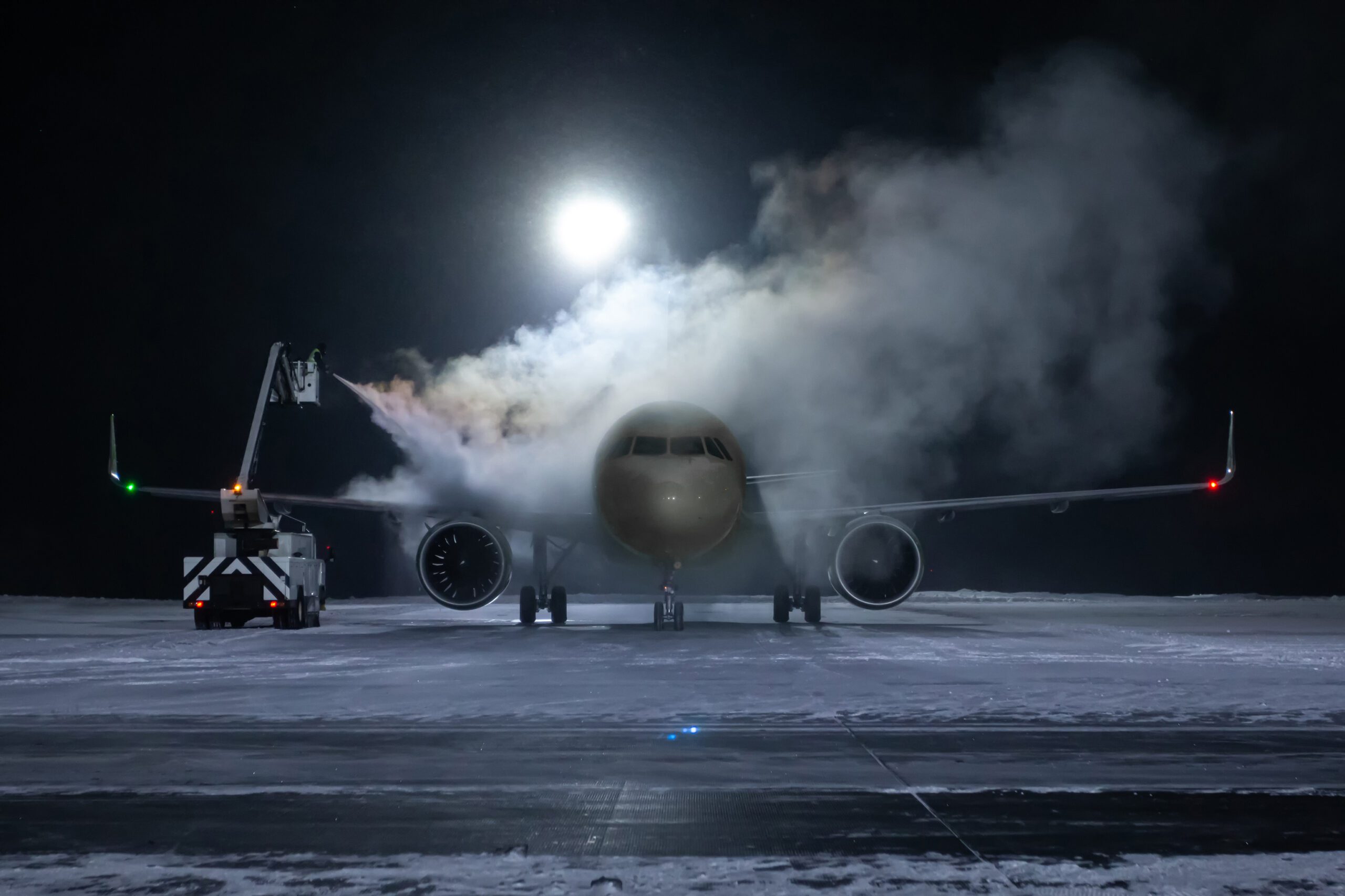

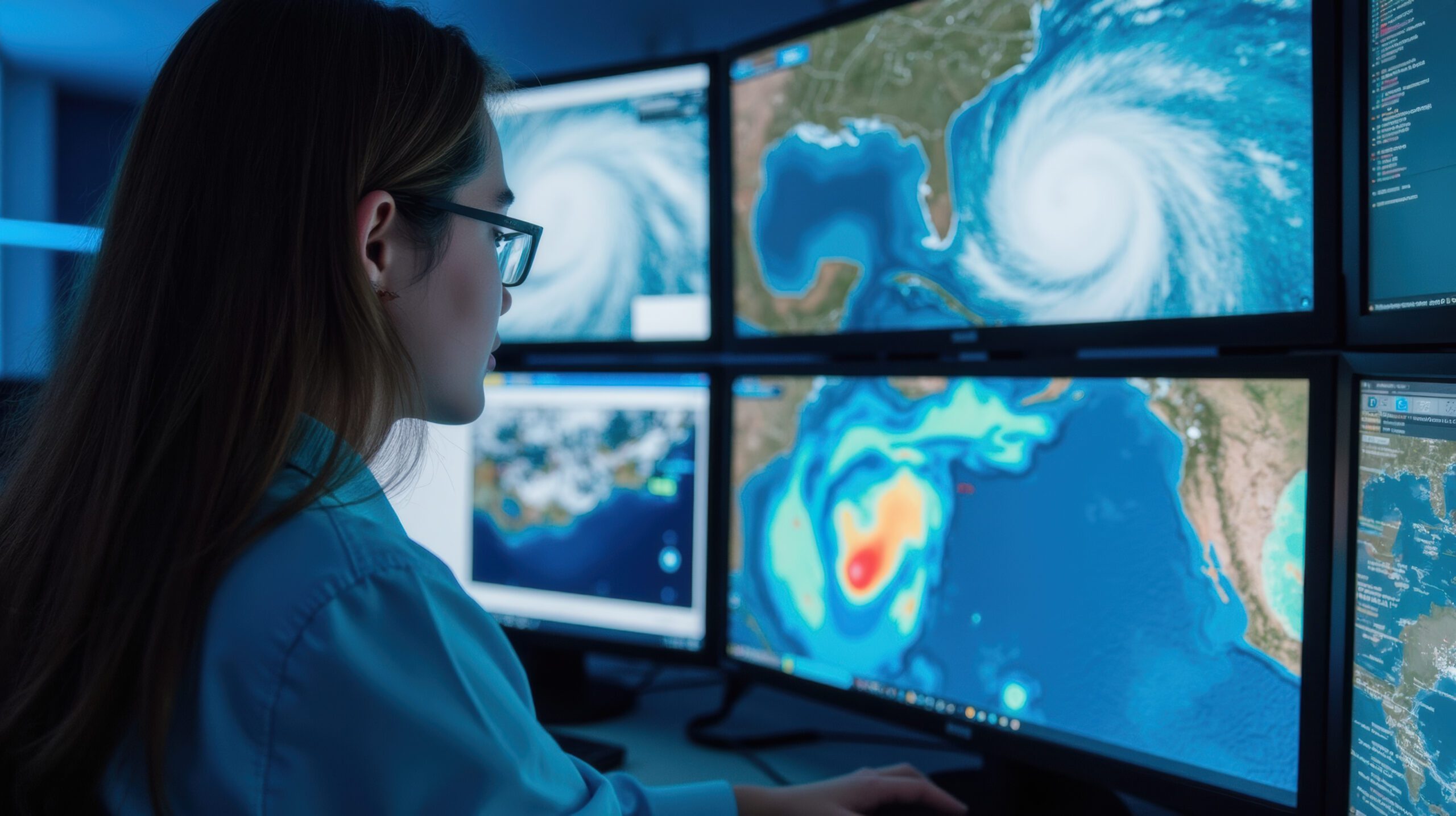






 Passenger experience
Passenger experience Strategic planning
Strategic planning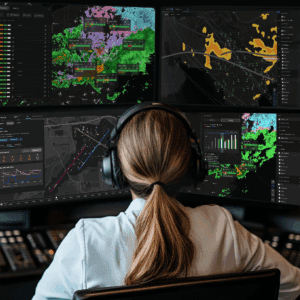 Flight planning and dispatch
Flight planning and dispatch In-flight operations
In-flight operations

